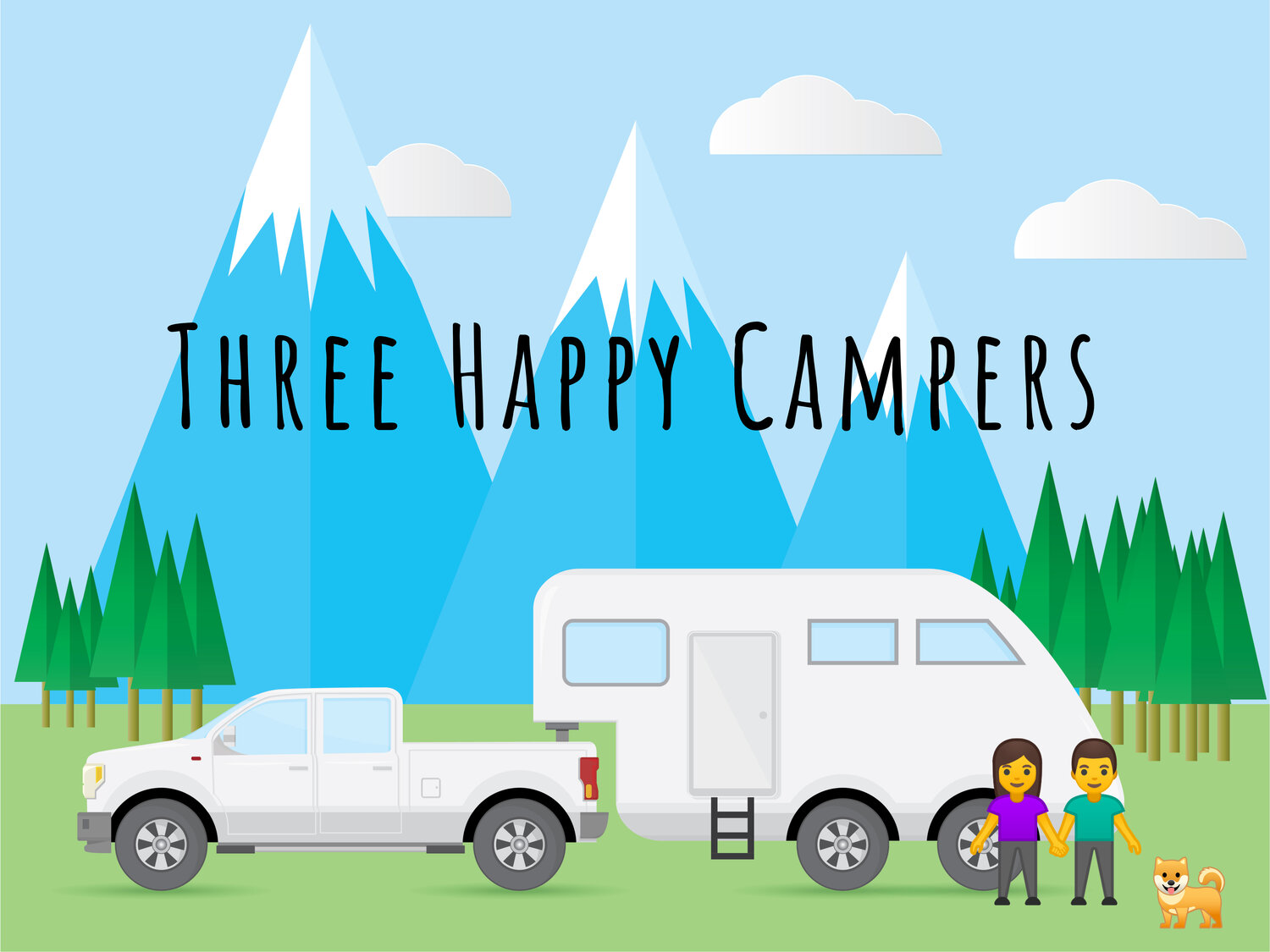Uncharted Territory-Nevada and Idaho!
Hello Everyone!
We have recently been in areas with no signal for the internet or phone. When this happens, we always take advantage of these opportunities and spend even more time outside exploring all that is around us. On this leg of our trip, we may or may not have seen things that will knock your socks off, but we did see beautiful scenery and hope you enjoy what we've shared!
On the way to Nevada, we drove through some remote desert areas like the one in the cover photo. One sign through this region read, "No Service for 135 Miles." This usually means no phone service in addition to gas stations and is where a full tank of gas, good tires, and a little prayer are all part of the preparation!
After successfully navigating the desert, our first stop was an RV park in the small town of Baker, NV (population 68!) which was right across the road from Great Basin National Park. Baker consists of precisely one (exceptionally good) restaurant (Kerouac's, 4.8 stars from 204 reviewers!), a post office, and a bar on the main strip, owned by our RV park owner. One evening we enjoyed chatting with a local "parky" (someone who lives in the area to work at a national park) and asked him about dangerous wildlife in the area. We learned there are zero bears in the basin and that there have not been for about 30,000 years. The parky said the most frightening thing we may see is a Tarantula Hawk. Say what?? Yep—just when you thought you had survived murder hornets, you find out about Tarantula Hawk Wasps. They are 2 to 3-inch long venomous wasps that inflict "the second-greatest recorded instantaneous pain of any stinging insect" and prey on tarantulas in particular. Once they have subdued their victim, they drag the spider home for the family to feed upon. Thankfully, they sting and haul tarantulas off much more often than humans. 😄
Another thing we learned in Nevada is how to pronounce "Nevada," properly. The locals told us if we were going to visit their state, we must learn to say, "Ne-VAD-a." VAD rhymes with BAD. We feel like posers not saying "Ne-VOD-a" as we have all our lives, but we are making every attempt to make the change.
We enjoyed several days in beautiful Idaho. Having never been here, we didn't know much about the state other than the strong potato association. Although the french fries and baked potatoes were particularly delicious here, there is so much more to Idaho. This state may very well be one of the best-kept secrets in the United States.
Montana is the next stop on our journey. Known as the Treasure State, it seems to be well-named from what we have seen so far! See you again soon!
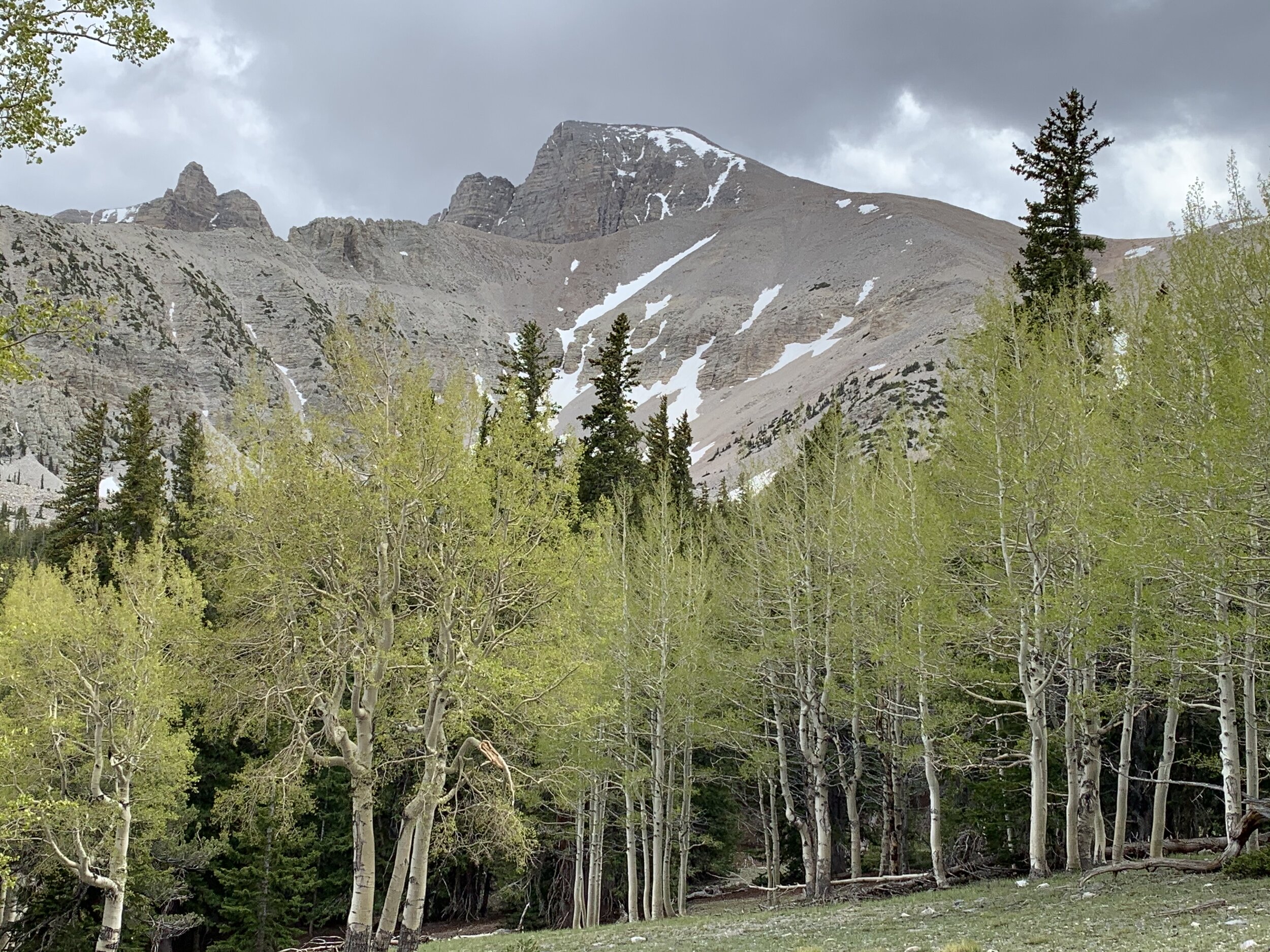
Great Basin National Park is named for the topography here; the basin, which is as it sounds, is a “sink” in the middle of the surrounding mountain ranges in California, Utah, Oregon, and Nevada. No water here drains to an ocean; all water either sinks into the ground, is evaporated or flows into lakes.
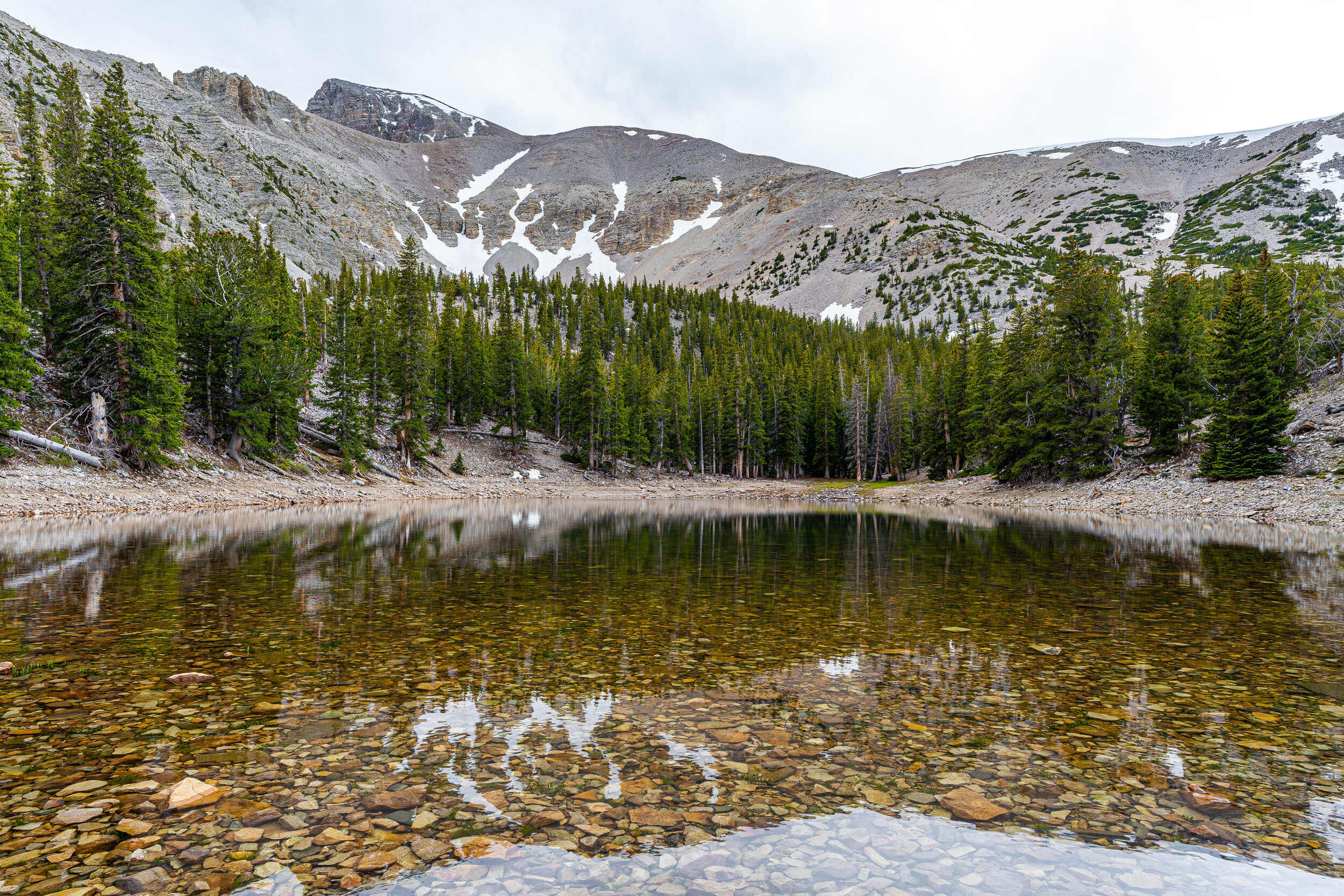
The lakes are crystal clear collections of melted snow and ice.
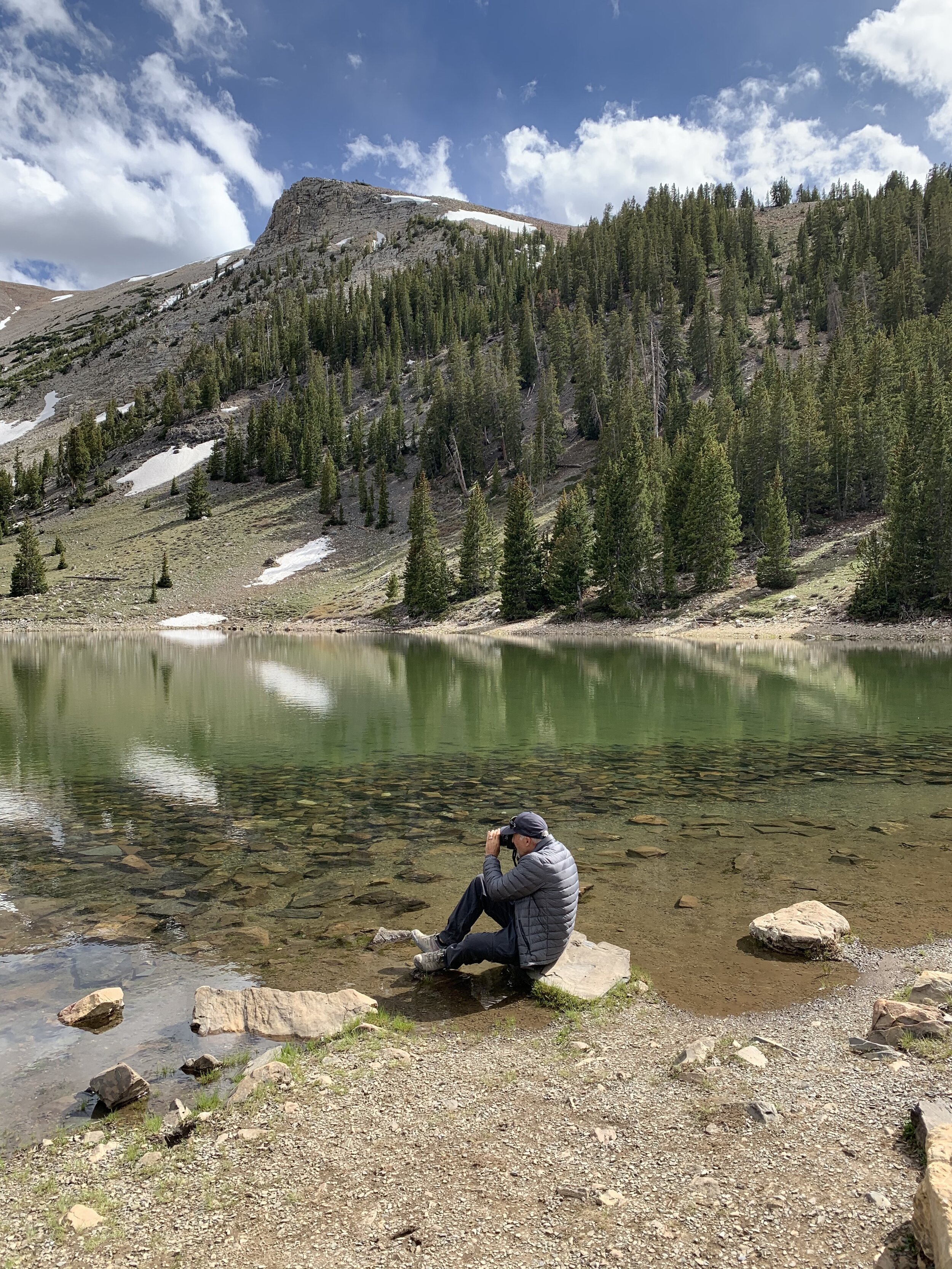
The pictures don’t really do this area justice; the colors are vivid and the air is so crisp, clean, and fresh.
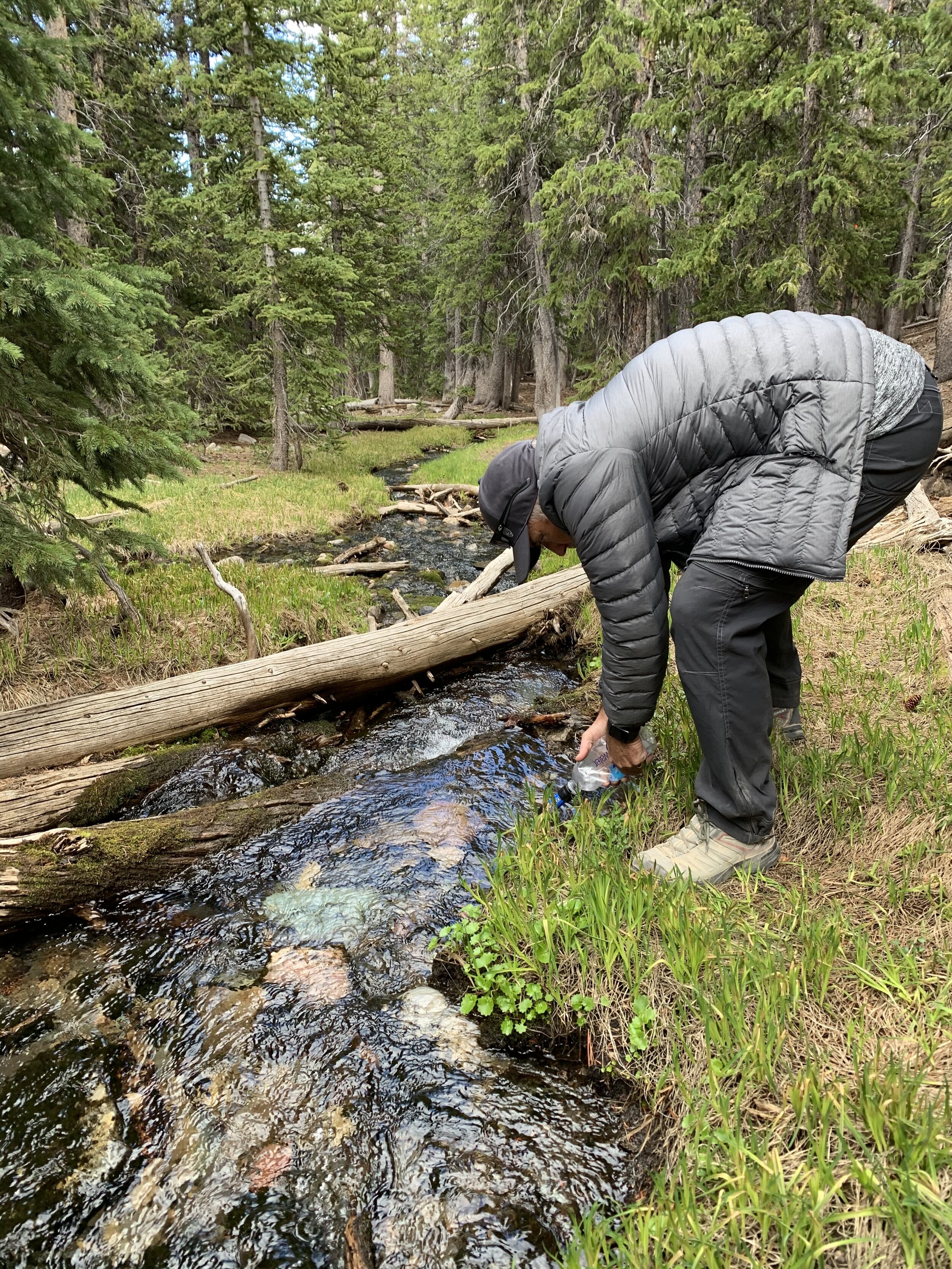
Along our hike, Craig tried out the water filtering system that our son, Curtis, bought for us. We drank the water and it was cold and delicious. Something tells me we may not have needed the filter in this park.
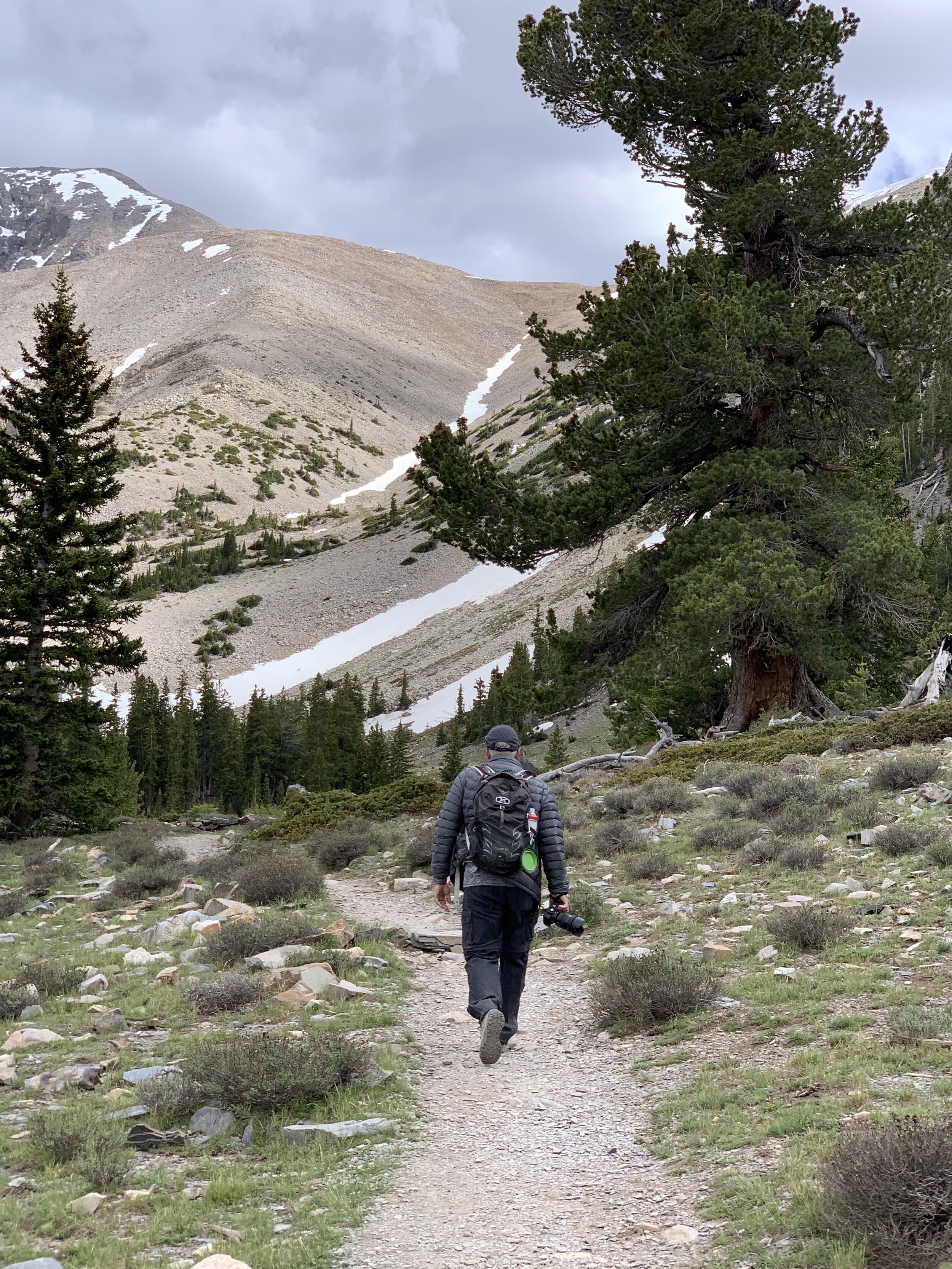
As we walked up the trail, it began to snow. The snow was unlike the fluffy flakes or the icy hail we are accustomed to in Georgia; the drops were white, frozen balls, like Dippin’ Dots!
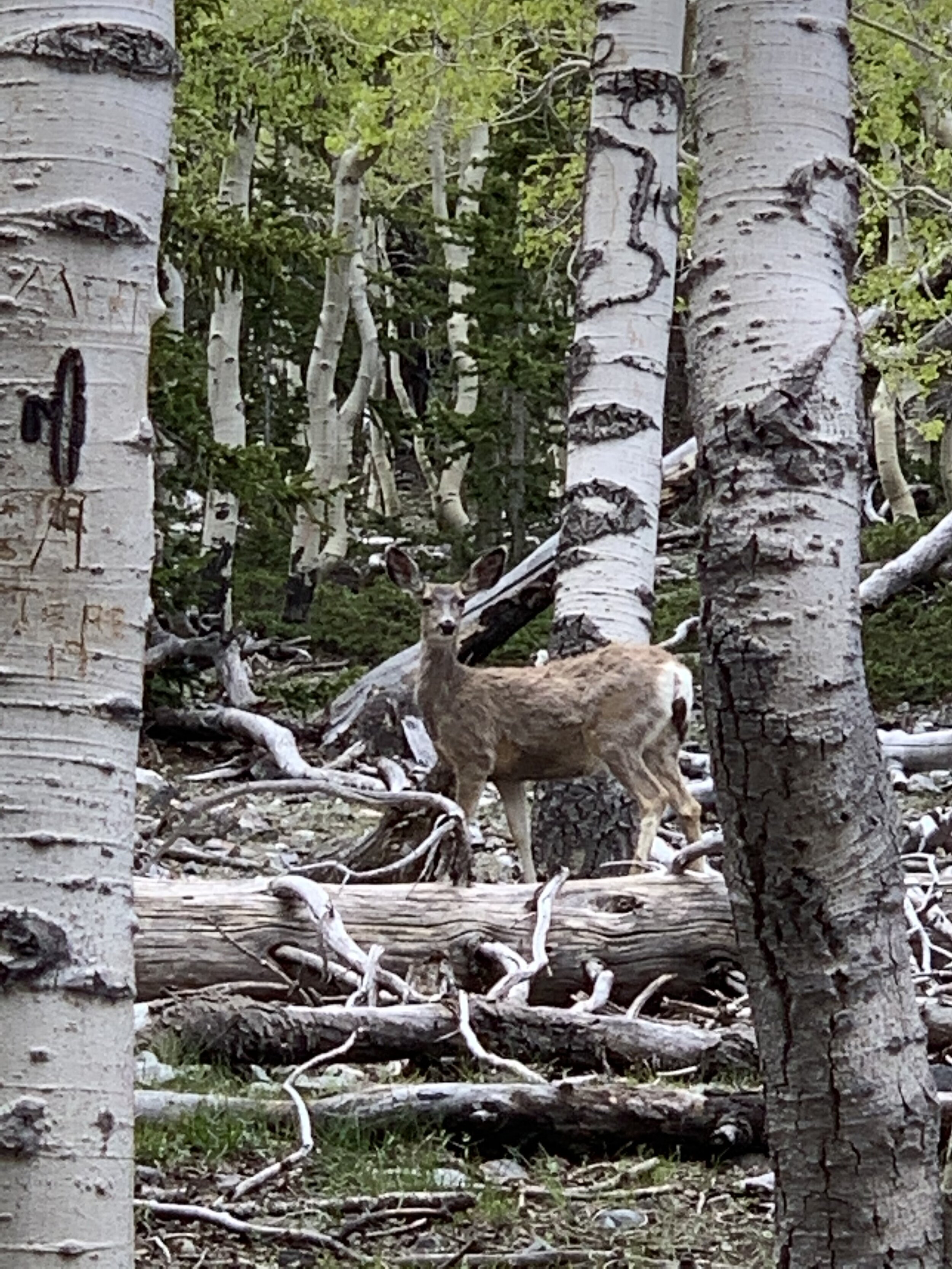
This mule deer was calm and grazed not too far away as I videotaped her. Mule deer are given their name because of their over-sized ears and are also distinct because of their white rump patch and black-tipped tails.
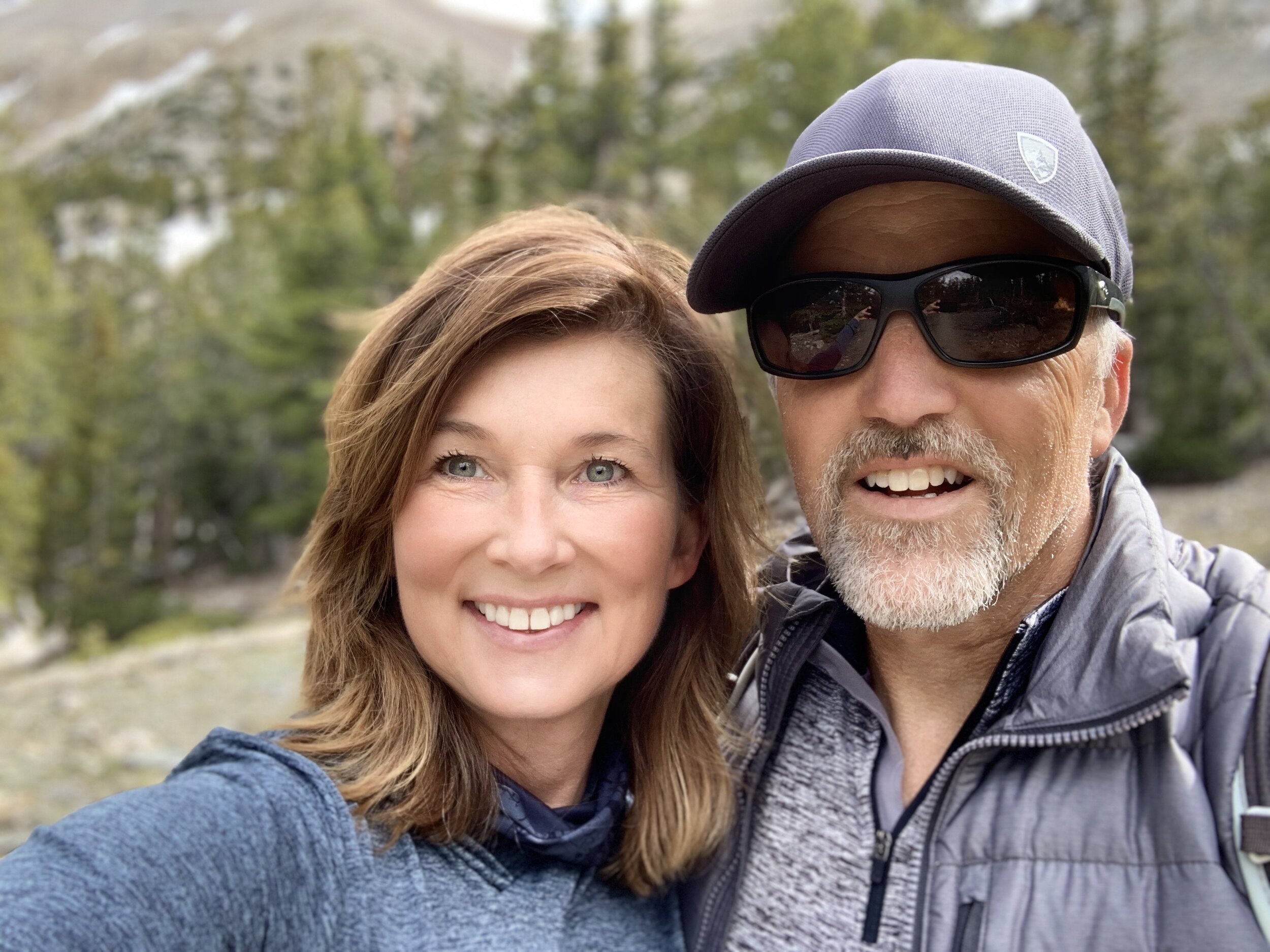
Great Basin NP is also known for the Lehman Cave tours. Unfortunately, due to the virus, the caves were closed. No worries, though…we continued our hike to the ancient Bristlecone Pine Orchard…hold on to your seats!
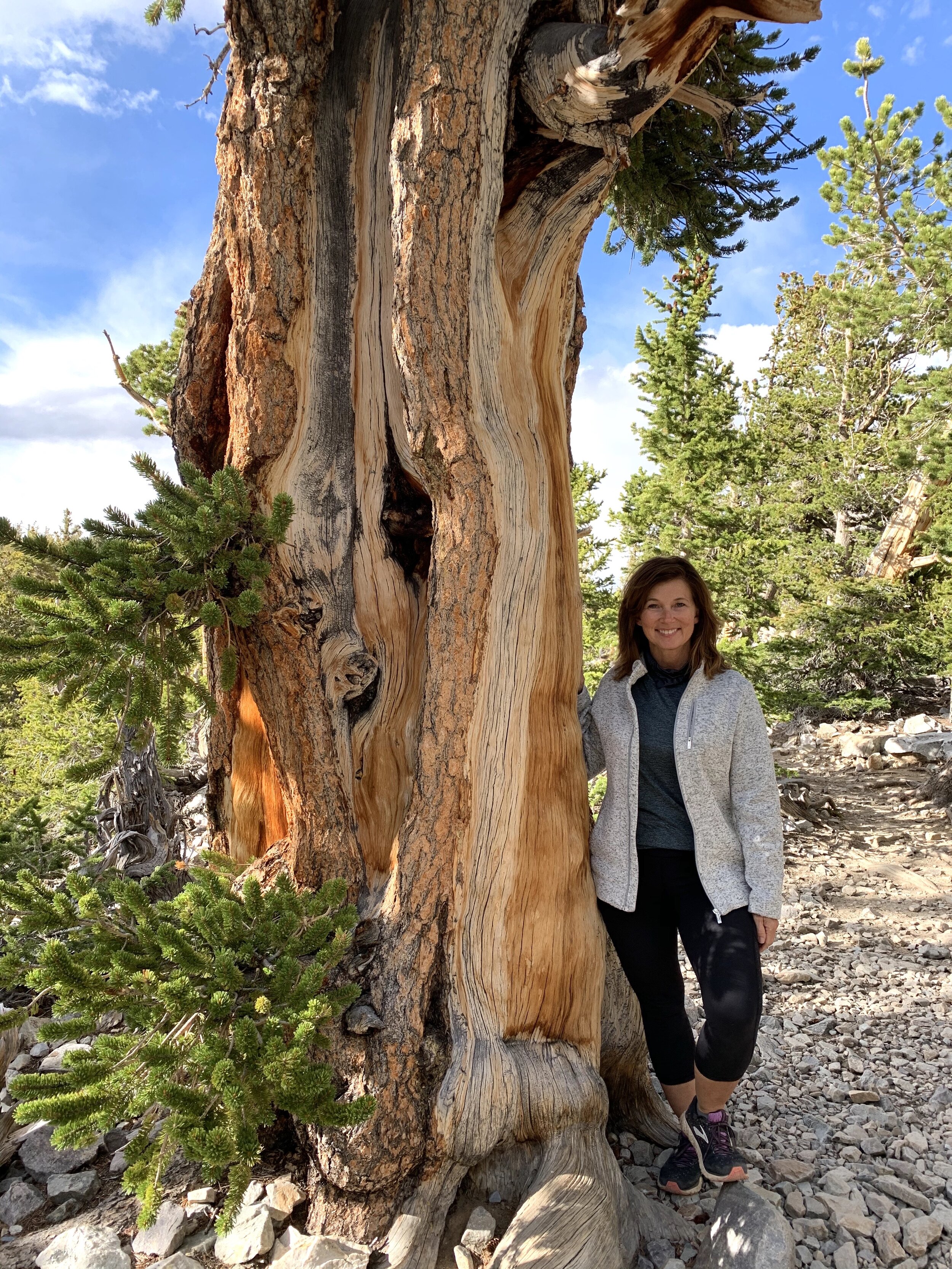
Bristlecone pine trees have bottle-brush shaped bristles that grow in batches. They’re special because some bristlecone pines are nearly 5,000 years old—the oldest living things in the world.
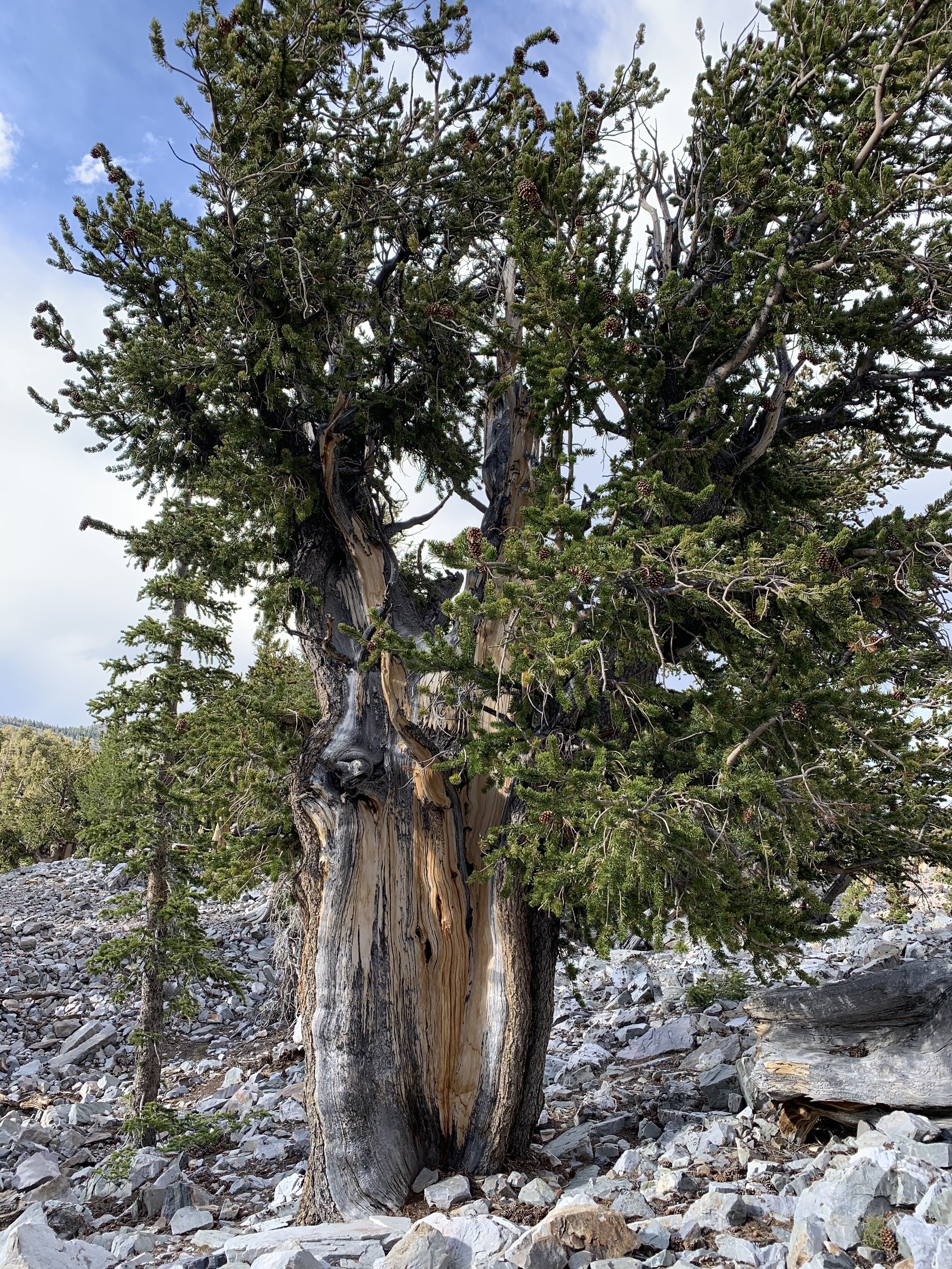
Bristlecones are found in extremely rugged sites in the high mountains of the southwest and grow to be so old because of their ability to adapt to harsh environments. They often live in isolation where other types of trees cannot survive.
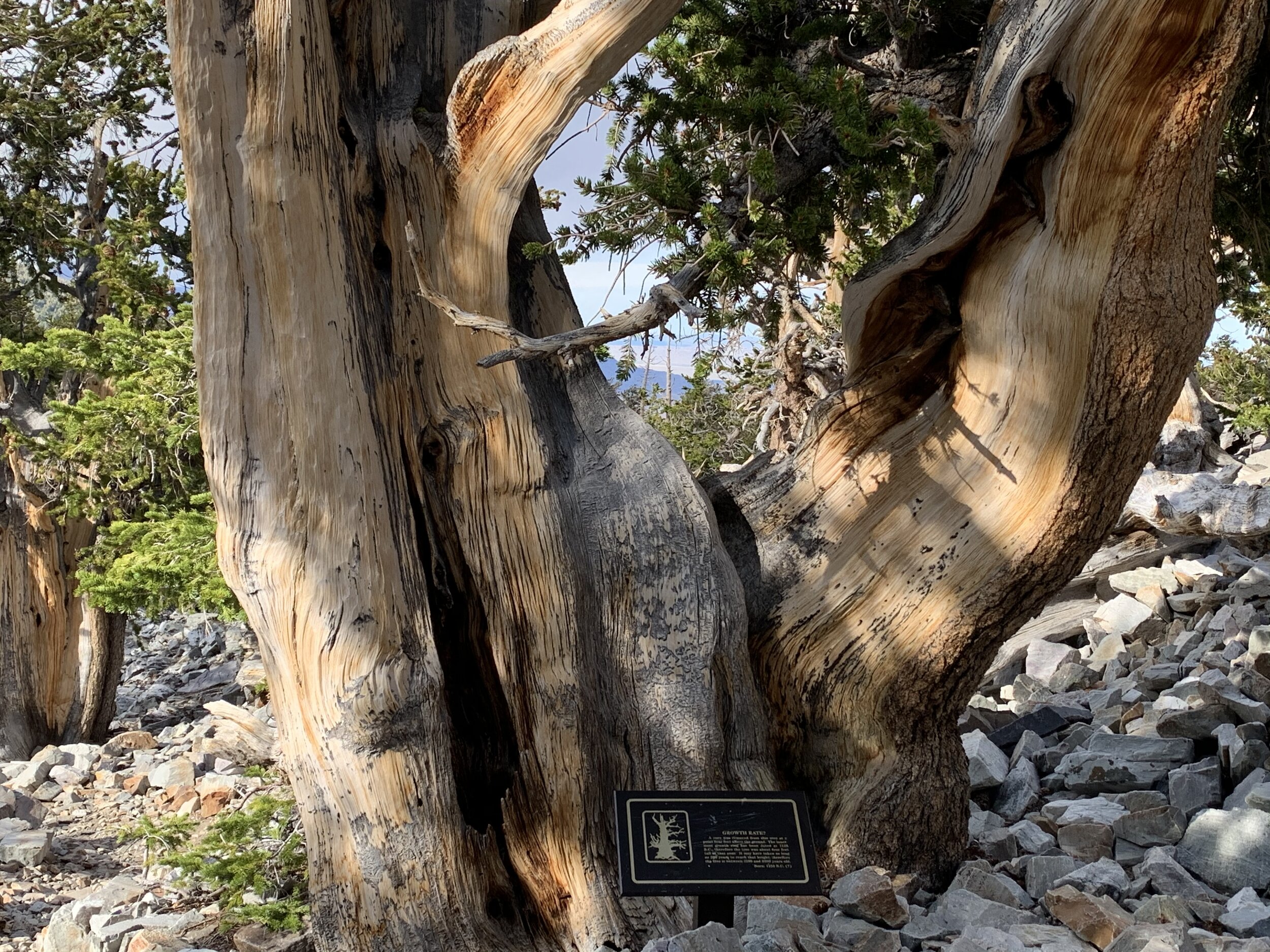
A core sample of rings shows this tree to be be “born” in 1150 BC, making it between 3100 and 3300 years old.
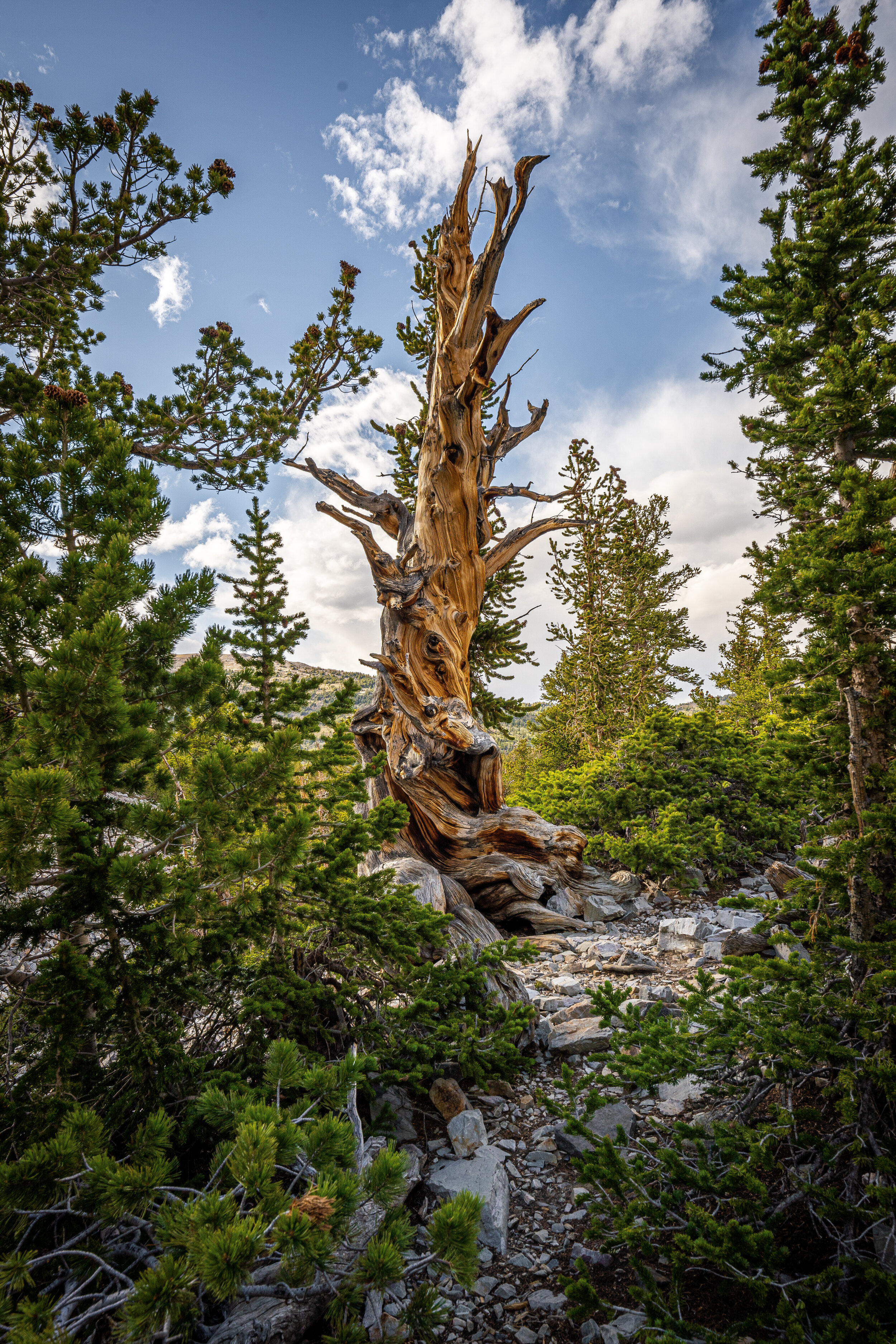
Bristlecones don’t die easily; they may cling to life for centuries after reaching old age. After they die, they may stand for hundreds of years longer before they fall.
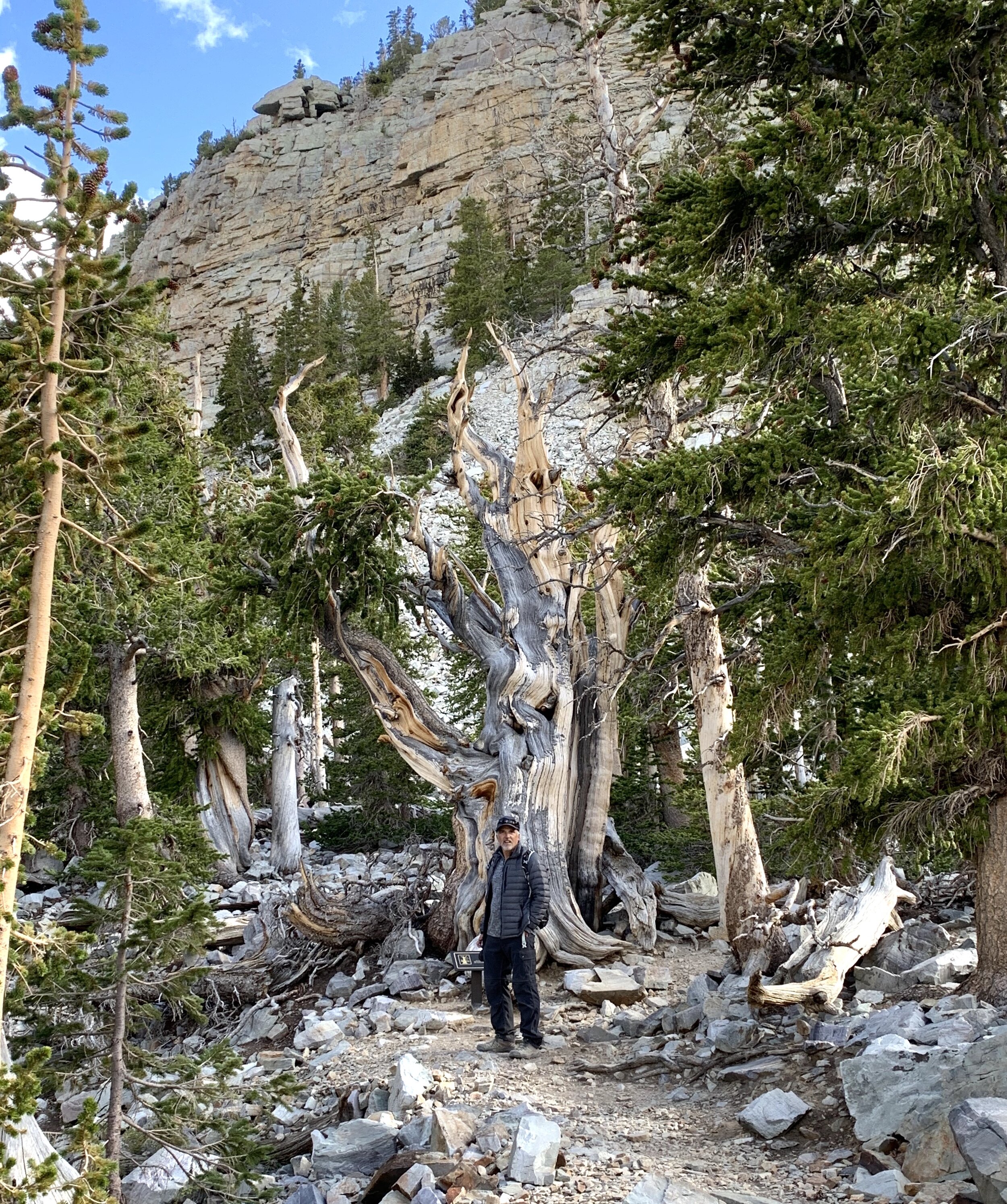
Their wood is resistant to insects and decay so instead of rotting, they slowly erode and are polished by the elements, almost giving them a sheen.
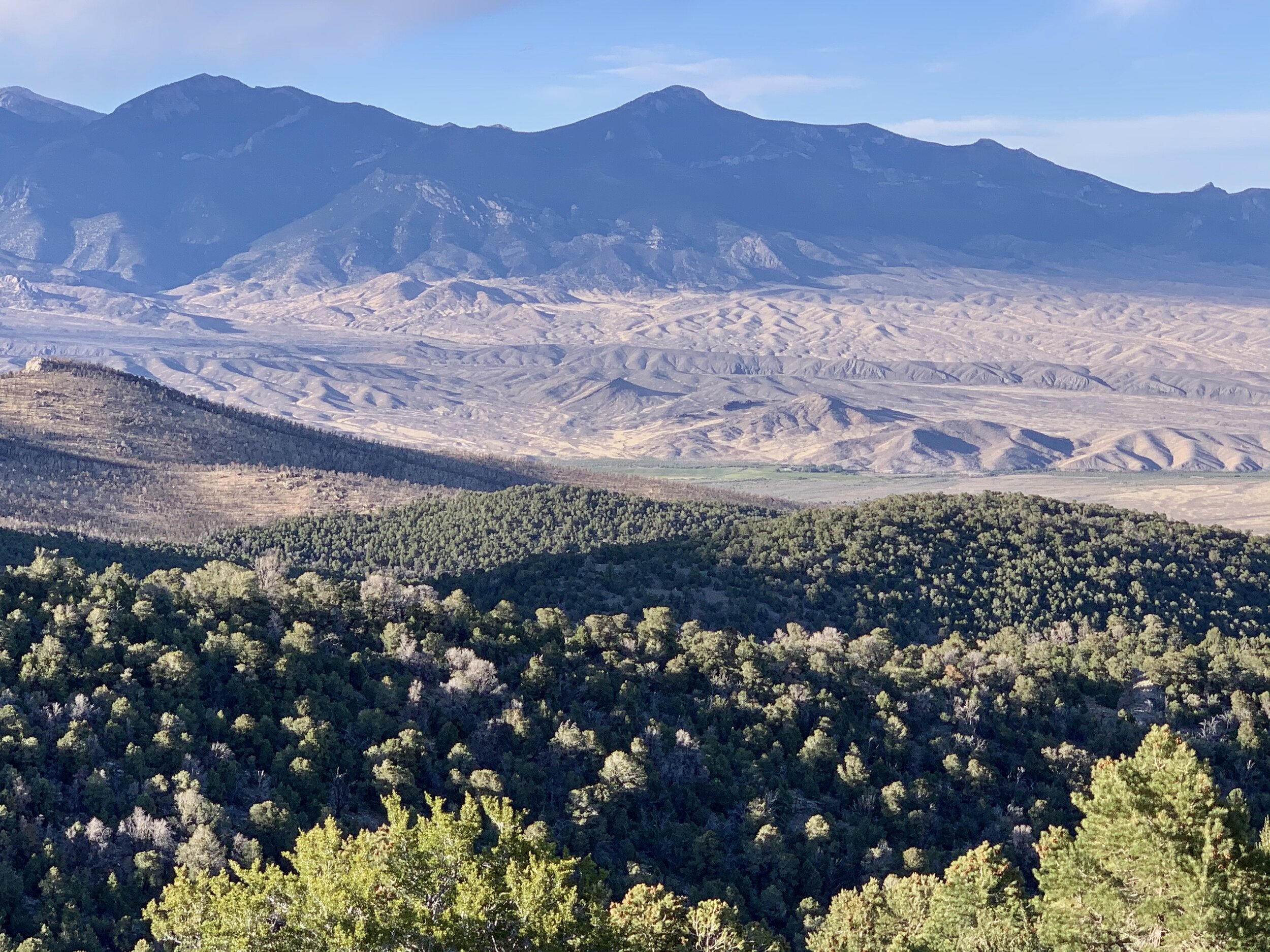
The drive home from the peaks of Great Basin National Park was also a beautiful sight.
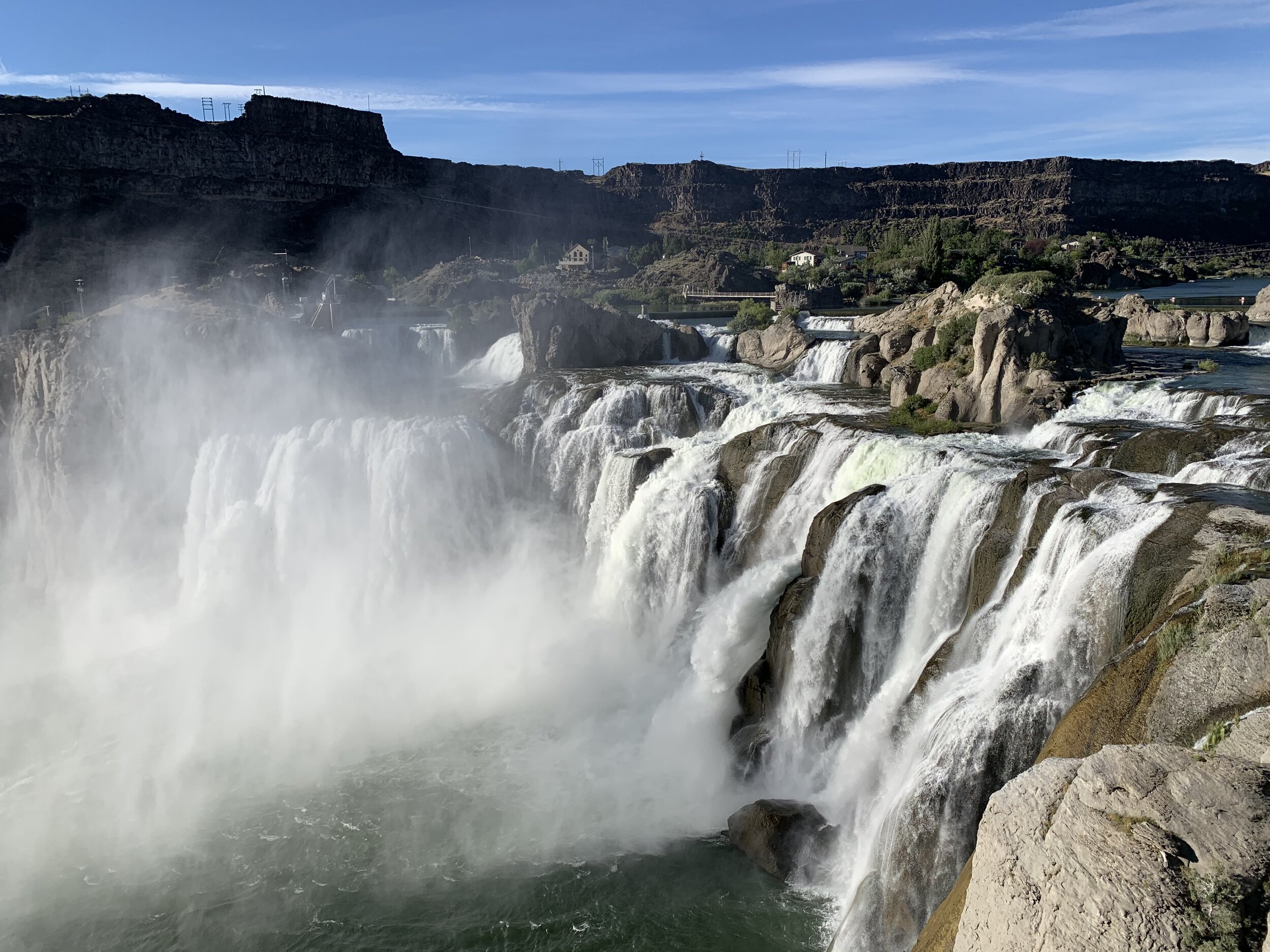
Immediately after arriving in Twin Falls, Idaho, we discovered the Niagara of the West, as Shoshone Falls is sometimes called. The falls are 212 feet—45 feet taller than the true Niagara Falls, and are over 1000 feet wide.
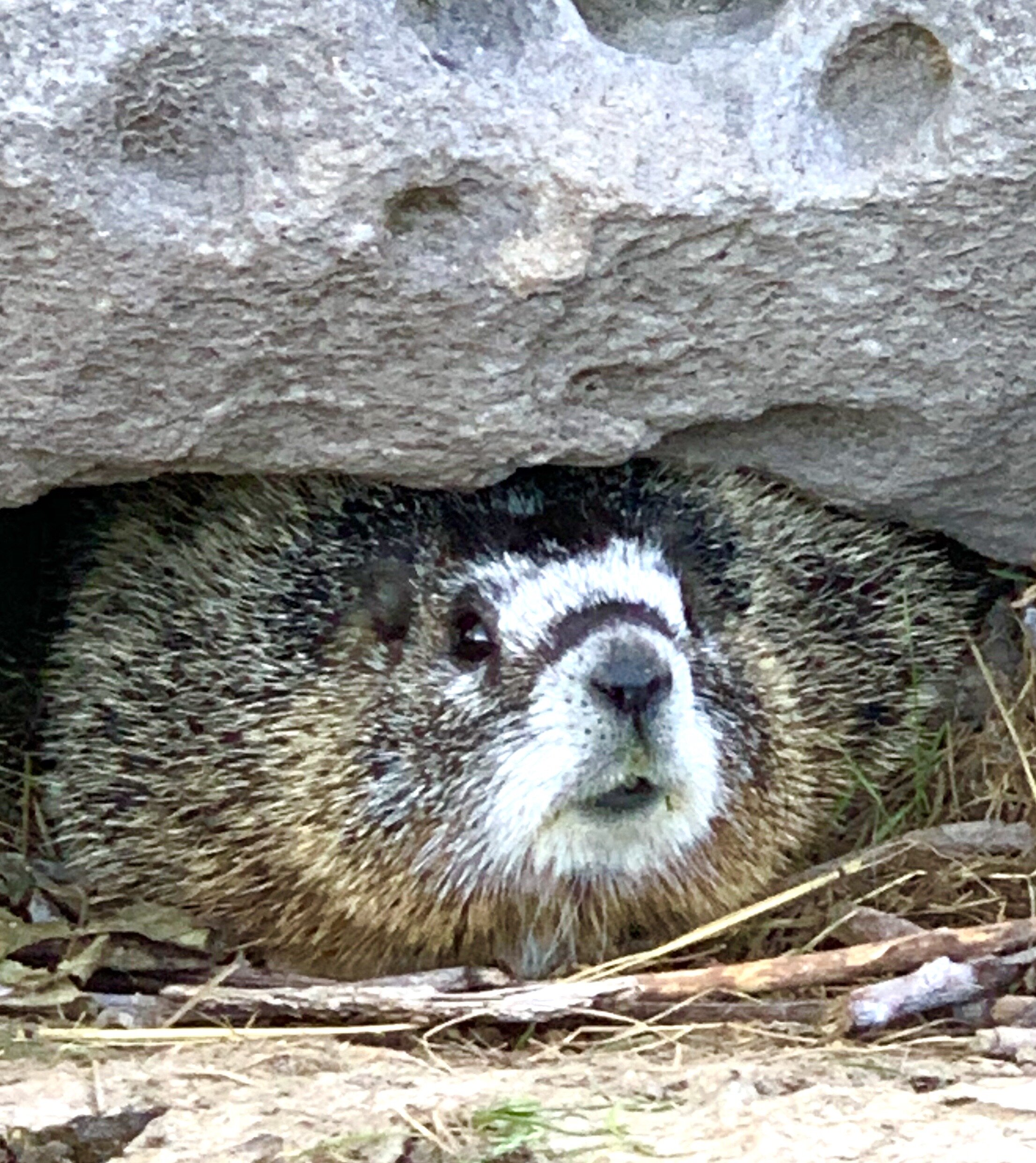
Shoshone Falls Park was a beautiful place with plenty of space for gatherings in the park, boating, hiking, etc. The grass is nearly neon green from all the fresh and clear water rushing from the falls into the Snake River. Here we also learned about “rock chucks” or the yellow-bellied marmot. Unlike their relative, the groundhog, they are not loners and live in colonies. They were everywhere in this park. It was a lot of fun watching these big things (8-12 pounds!) interact with park visitors.
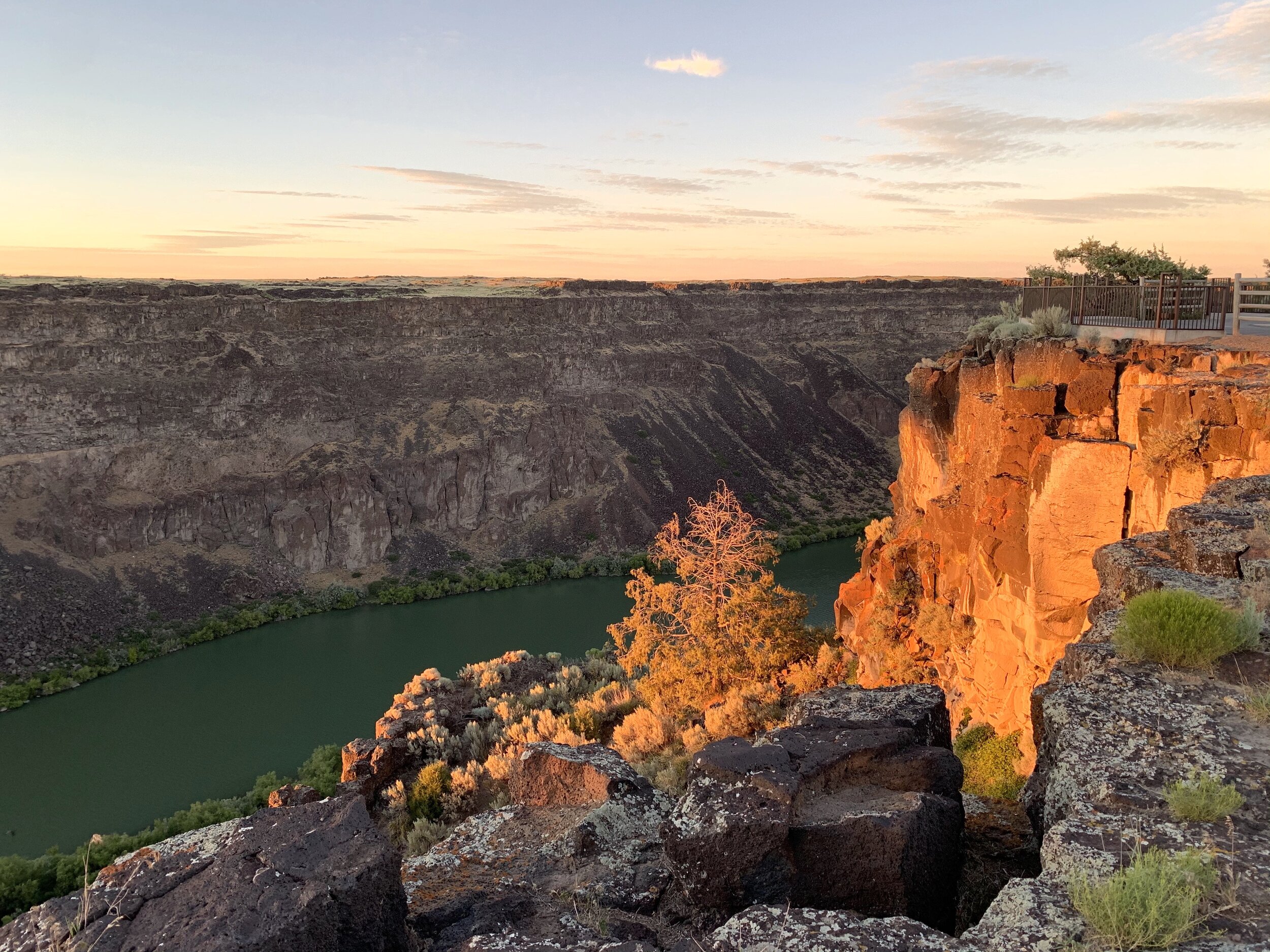
After observing the falls and marmots at Shoshone Falls Park, we heard we should drive a few miles down the Snake River to see the Perrine Bridge. It seems our timing was perfect; we arrived just as the sun was beginning to set on the rocks.
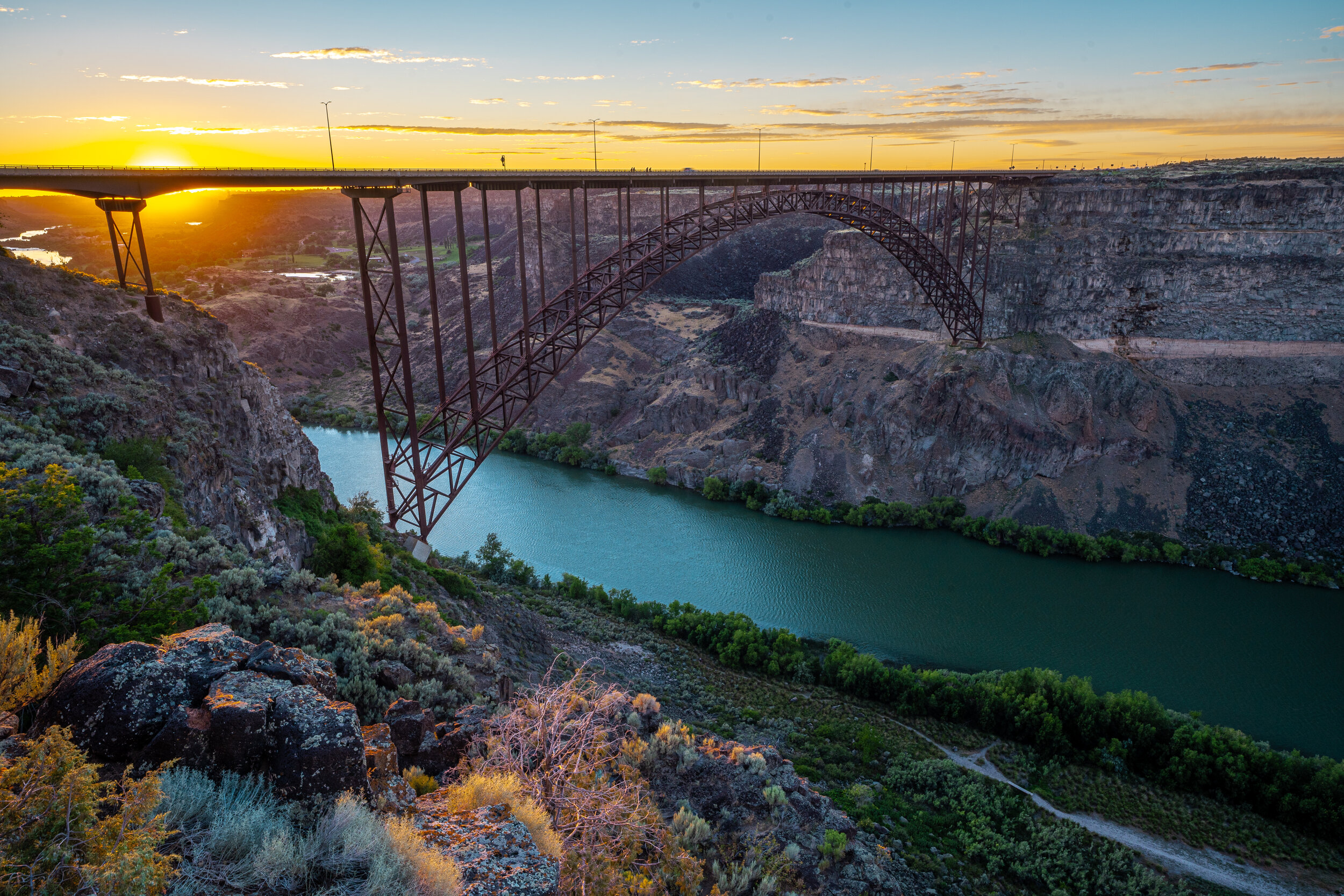
The Perrine Bridge is about 500 feet tall. If one desires to jump from the bridge with a parachute, there is a service for that, and it’s a daily activity here.

This jumper decided to get fancy and do a backflip.
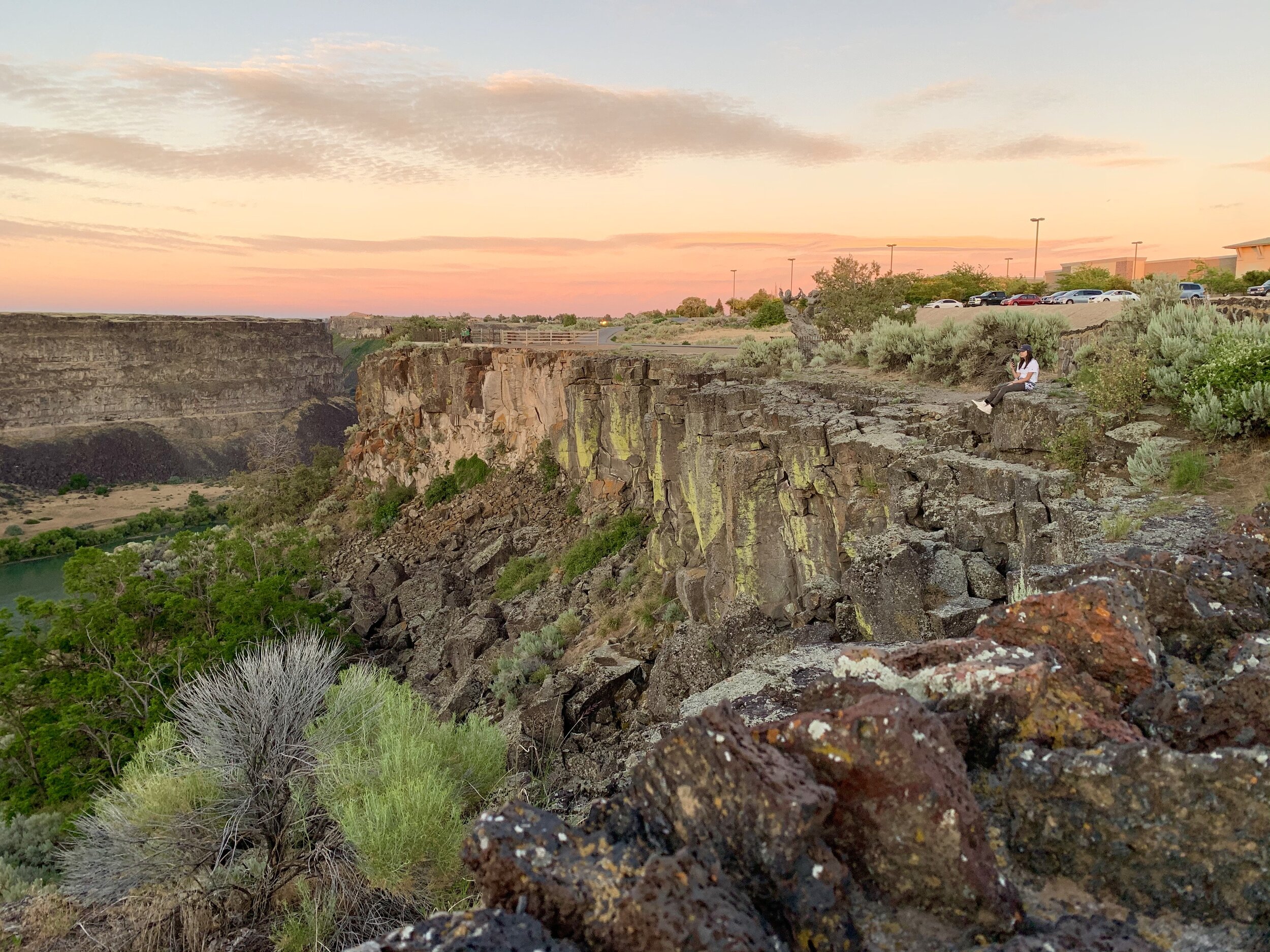
As breathtaking as the Snake River was at the Perinne Bridge, we also marveled that all this beauty was at the edge of a Best Buy and TJ Maxx parking lot!
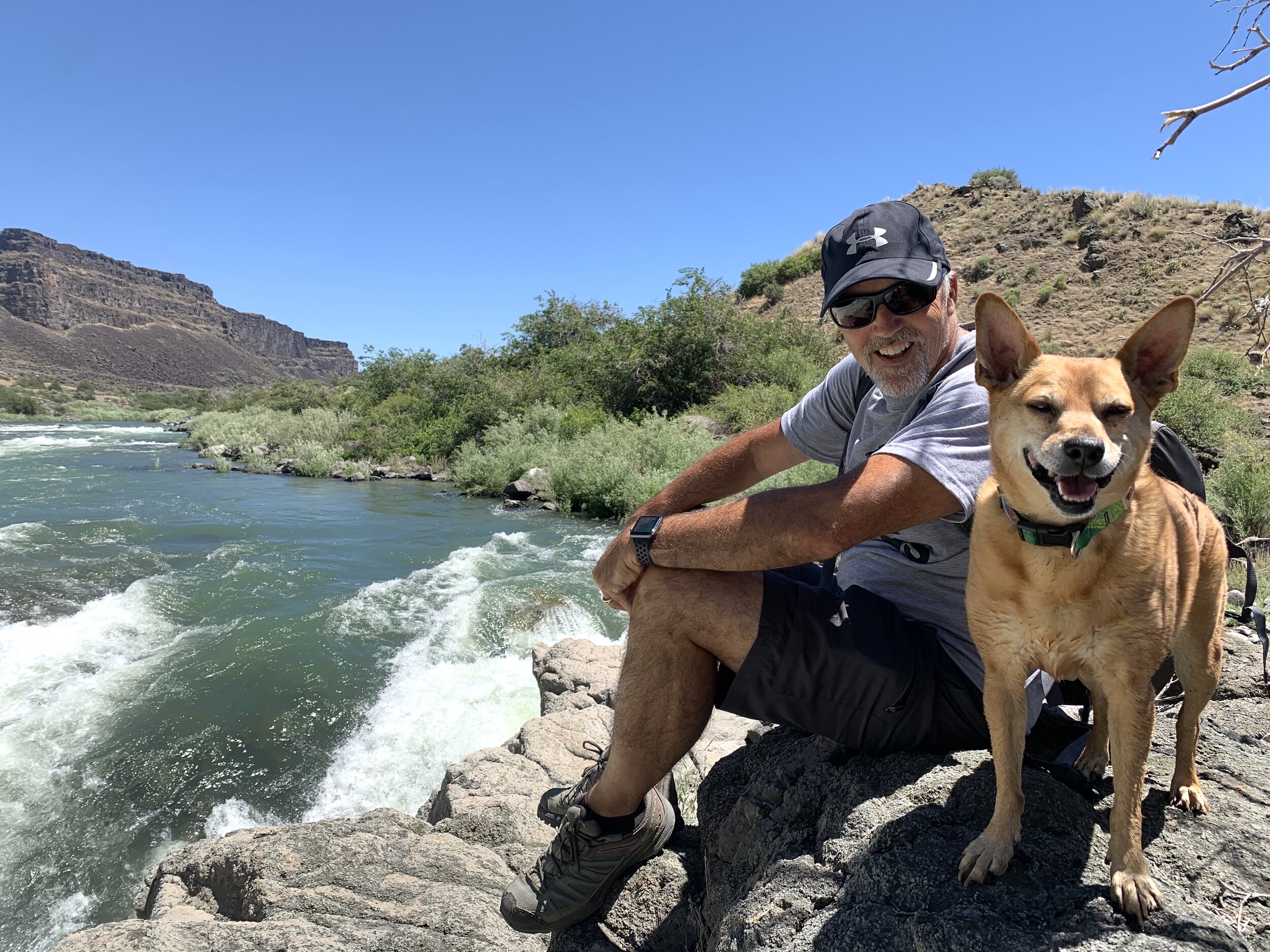
On another day, we hiked along the Snake River at Auger Falls Park. It was hot and we enjoyed our breaks by the rushing water.
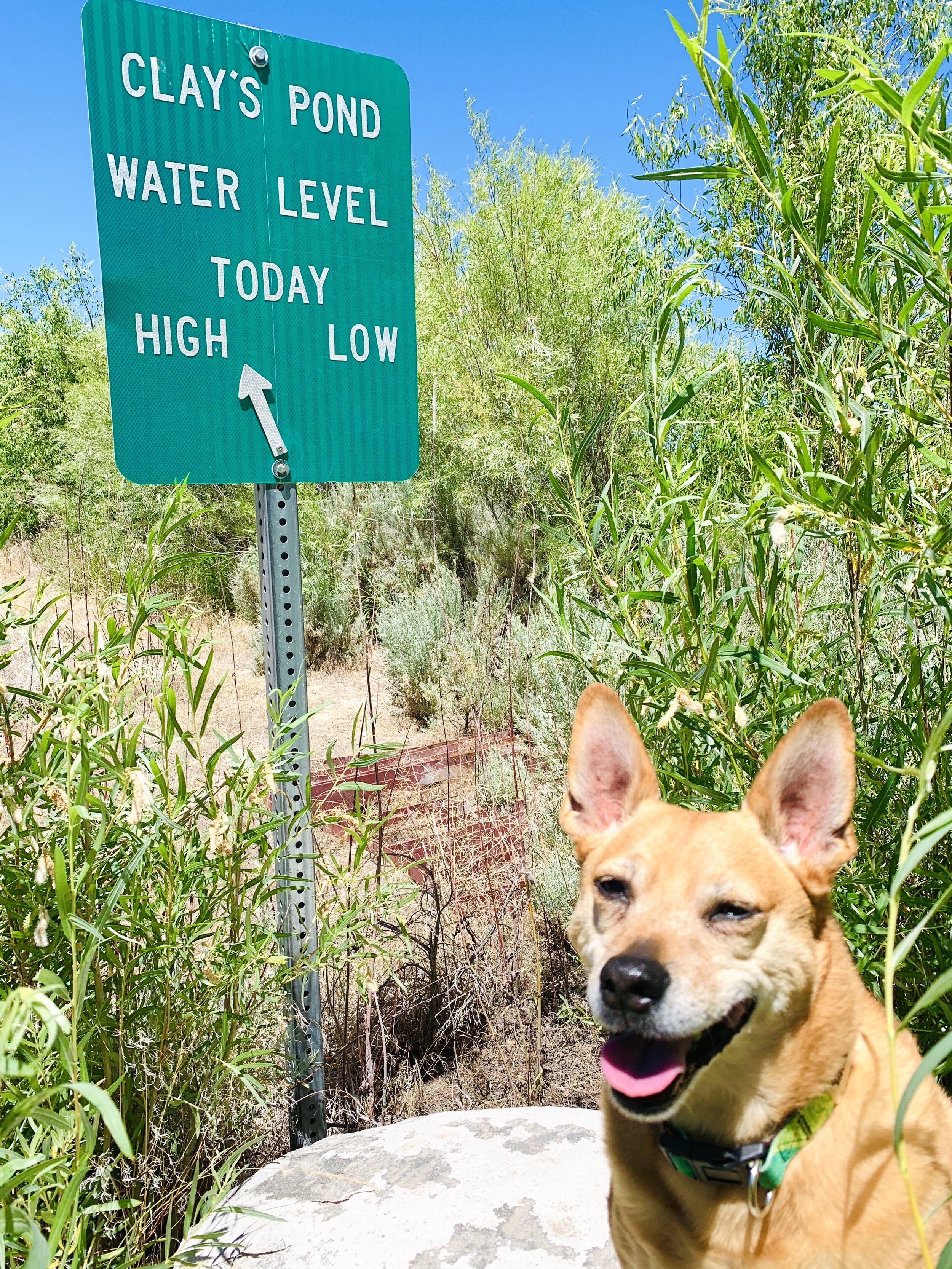
Clay had a particularly favorite watering hole.
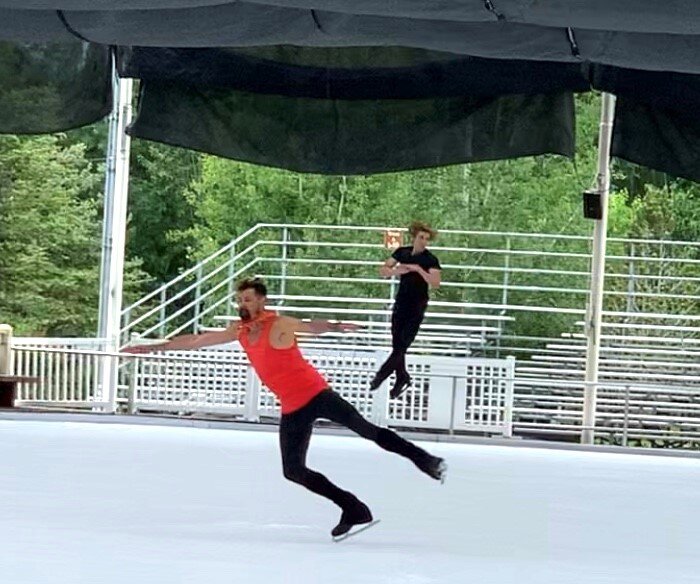
On Craig’s birthday, we were in Sun Valley, Idaho. Sun Valley is a ski resort town that boasts being home to fifty-six former and current winter sport Olympians. We knew many Olympic ski medalists lived and trained here, but were surprised when on a bike ride, we came upon an outdoor ice skating rink (in June!) with several expert-level ice skaters. The guy in the back nailed every triple-axel he attempted. The guy in the front had an equally impressive spin. I would have watched them all day. Craig said that would have to be done on my birthday, not his. 😂
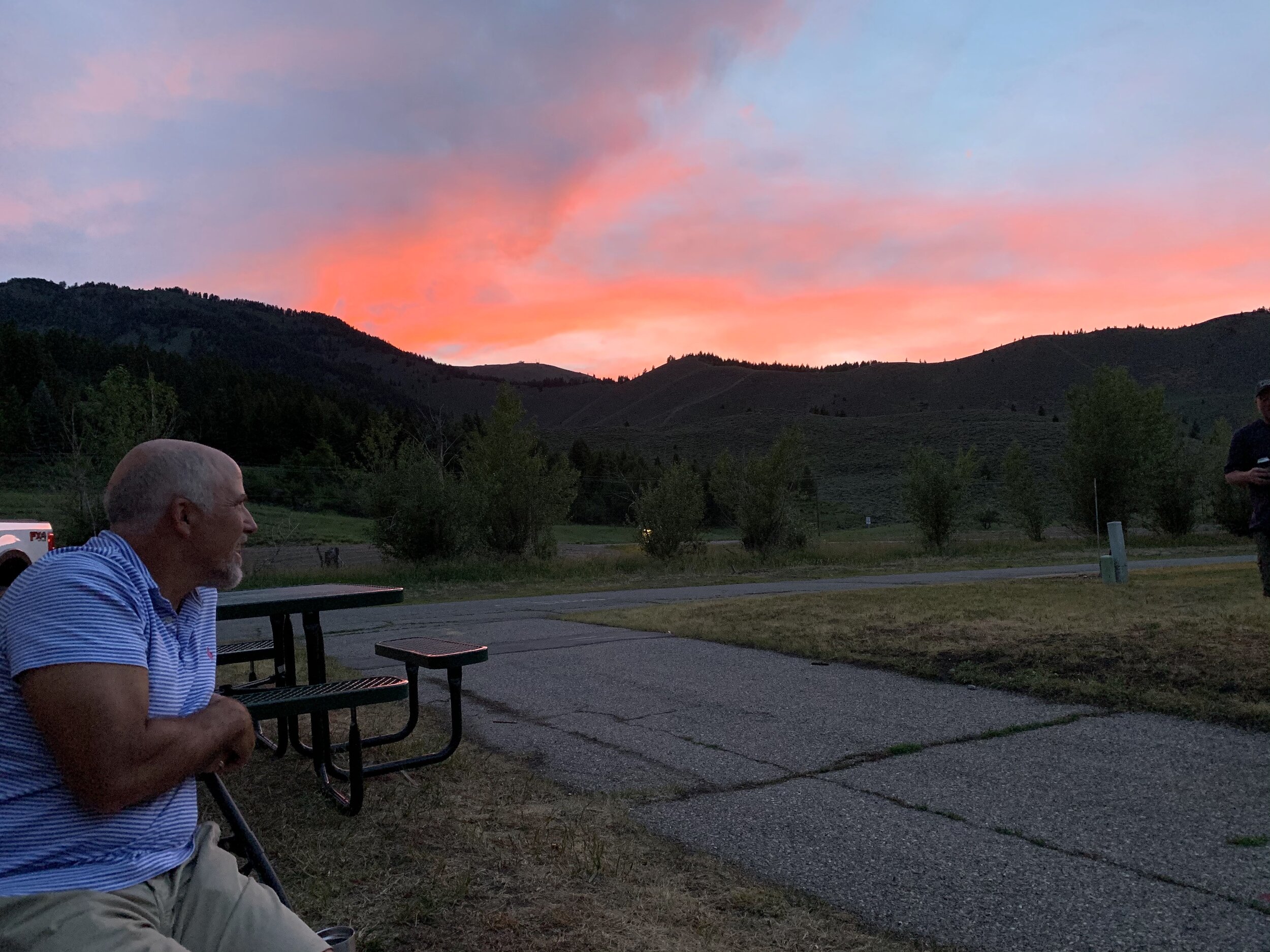
Ketchum, just outside of Sun Valley is a remote town with many of the same year-round outdoor treasures Sun Valley offers. The population is only about 2500 in this town of beautiful sunsets and mountain ranches, and because of it’s seclusion and great beauty, many celebrities have chosen to live in the area, including Tom Hanks, Arnold Schwarzenegger, Mark Zuckerberg, and Warren Buffett to name only a few.

After Craig’s birthday dinner at the famed Pioneer Saloon in Sun Valley, we went back to our RV park in Ketchum and enjoyed the sunset and visited with the “neighborhood” kids who wanted to take Clay for a few spins around the park. Clay obliged.
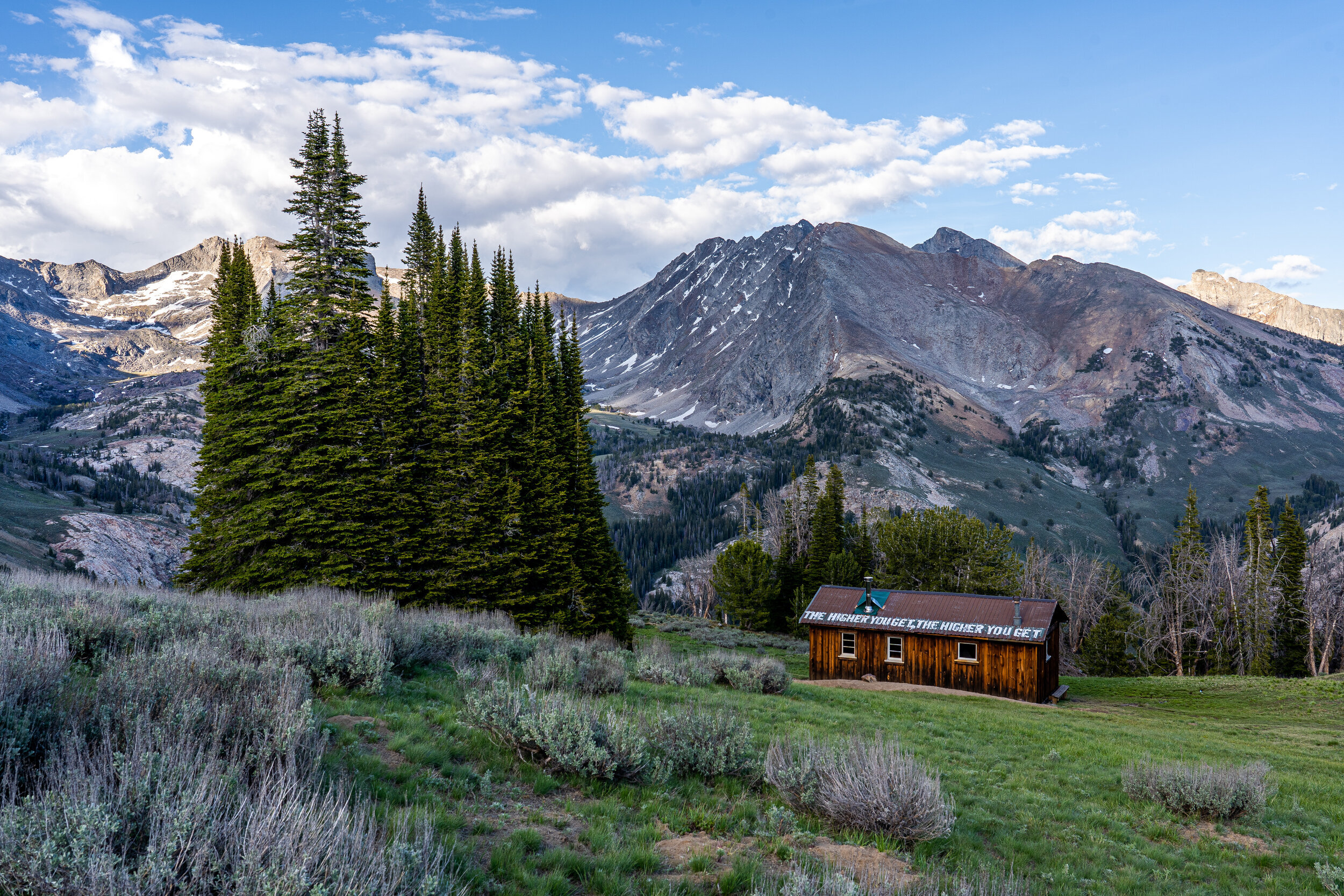
The Higher You Get, The Higher You Get This first-come, first-served cabin in the area is open for any group of hikers to stay overnight. Craig found the door unlocked and instructional notes hung everywhere for managing the amenities, including cookware and firewood.
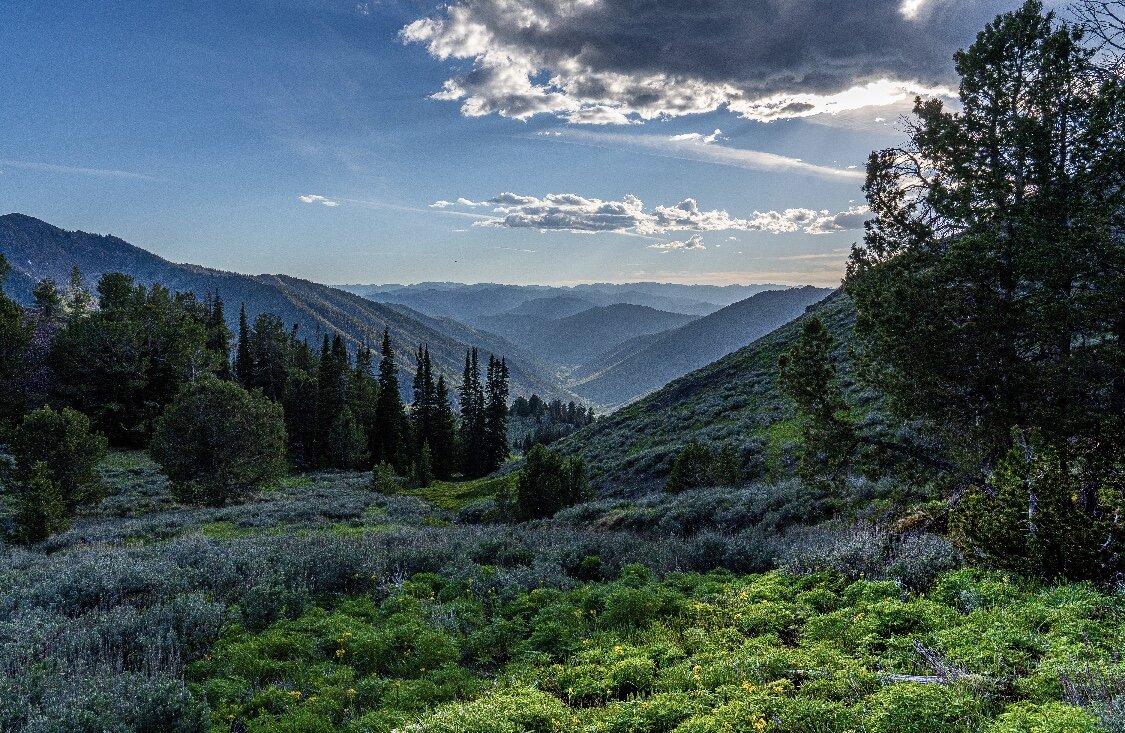
About 60 miles north of Ketchum we visited another treasure; Redfish Lake in the Sawtooth National Recreation Area. We will make every attempt to visit here again for a summer or winter vacation.
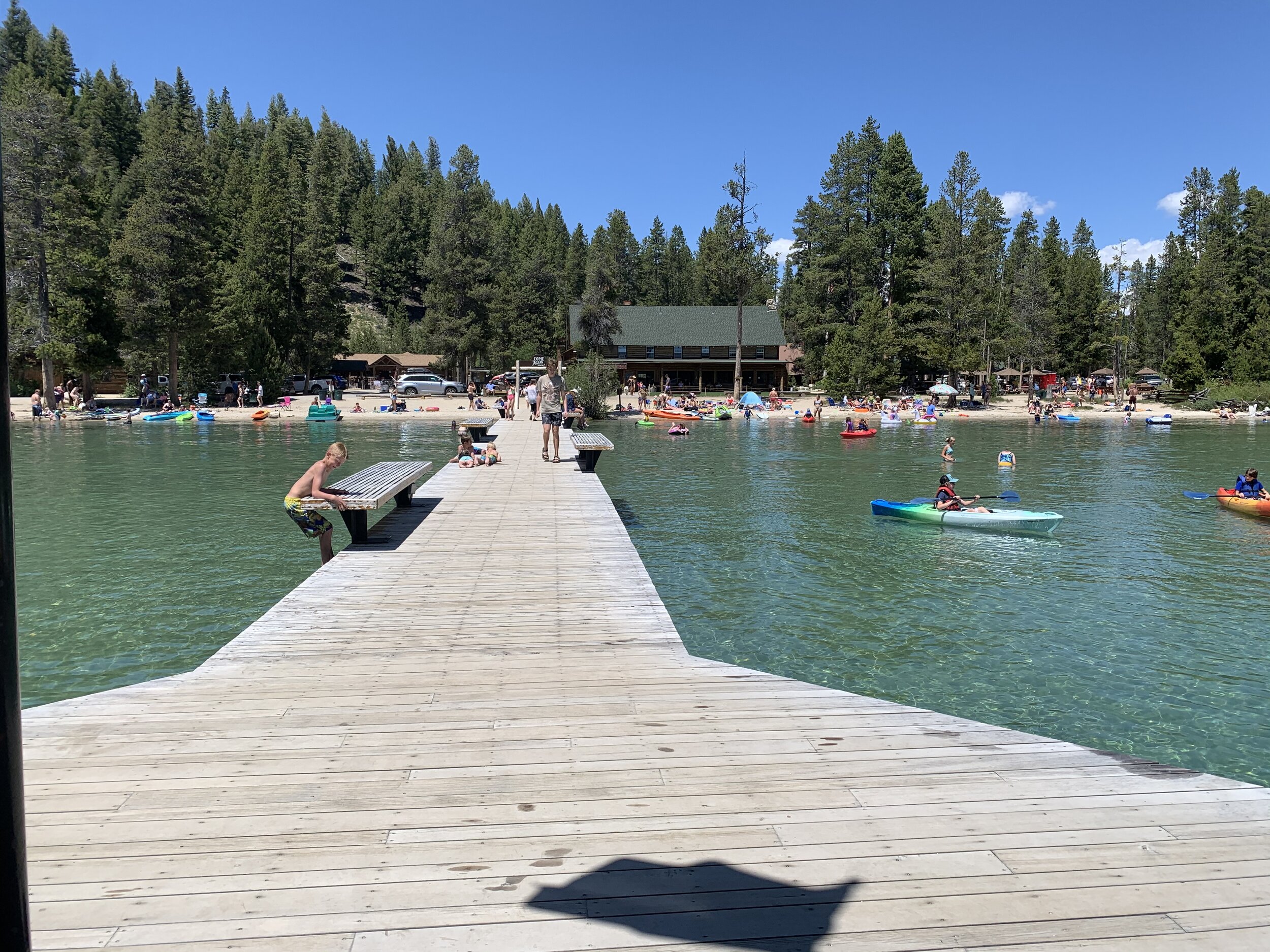
Redfish Lake has mountain lodging, boating, hiking trails and water activities. Until reaching deep waters, you can see to the very bottom through the crystal clear water. This place also had the most pristine dog beach you’ve ever seen!

A boat shuttle took us to a trailhead where we would hike almost 9 miles back to the lodge.

The Sawtooth Mountains are named for their short and ragged mountain tops.
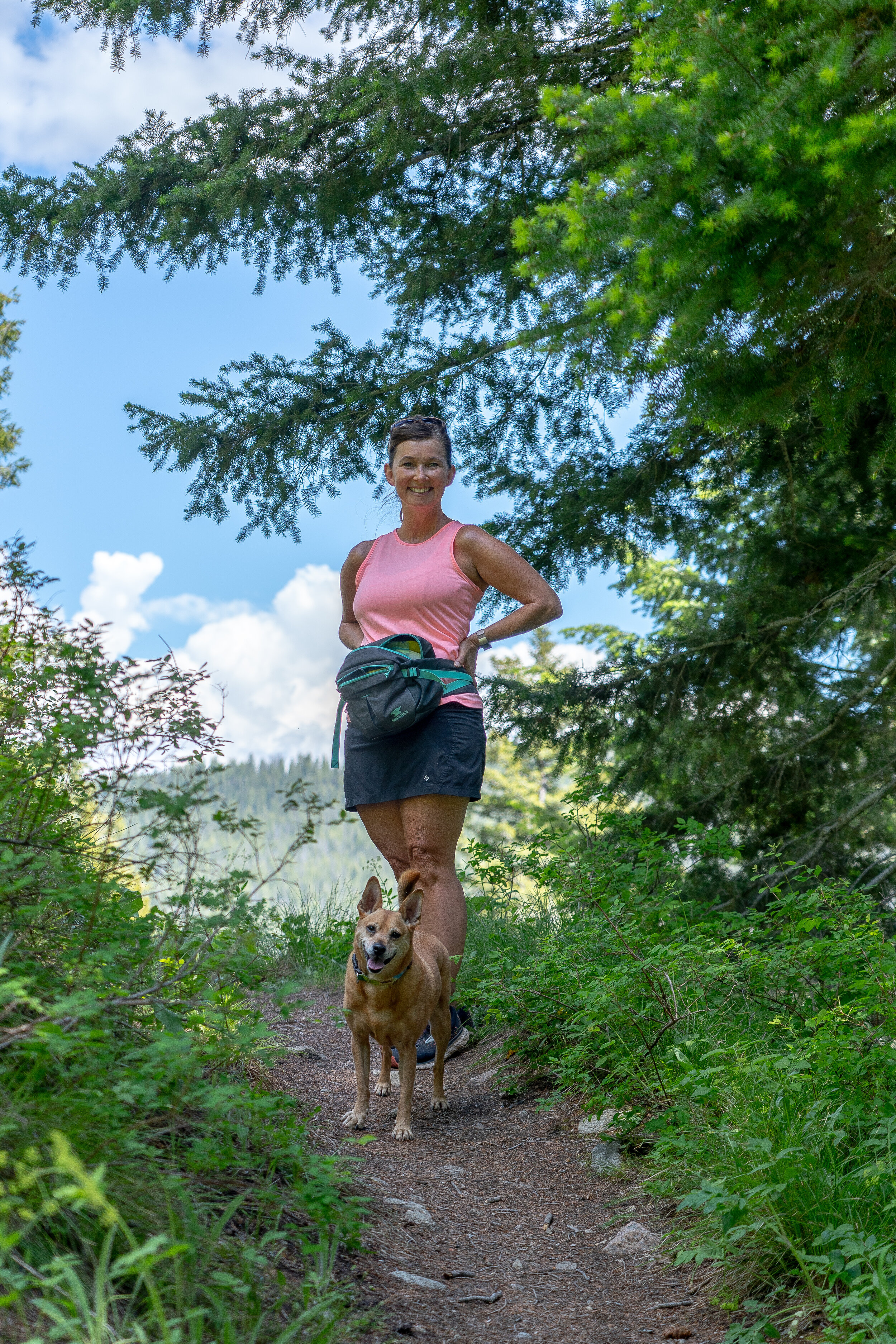
It was a long hike, but we promised ourselves ice cream from the snack bar when we returned, and that kept our spirits high. 😊🍦
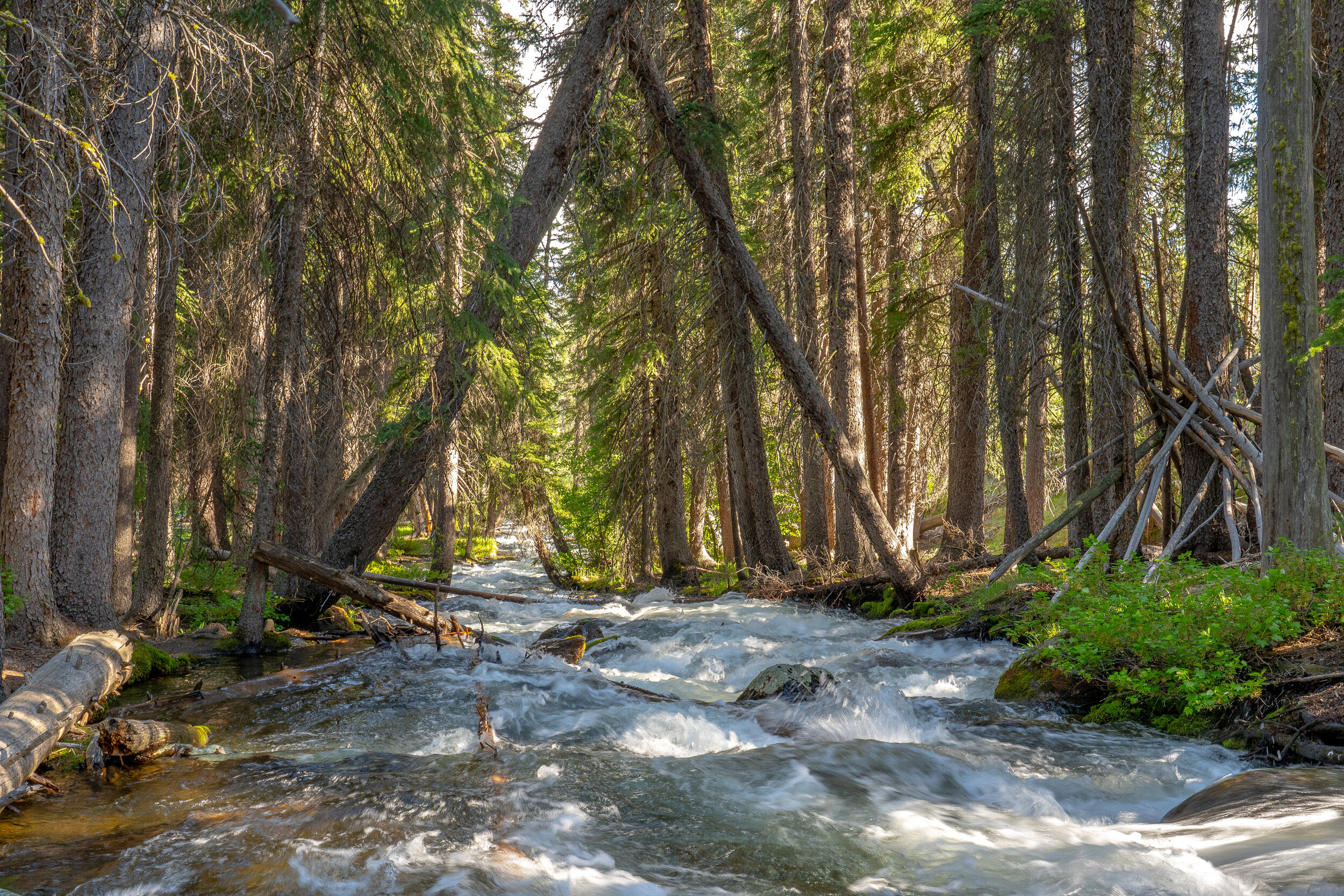
At the very end of our Redfish Lake hike, we came upon this beautiful stream under a canopy of pine trees. So serene and a great place for me and Clay to stick our feet in the water.
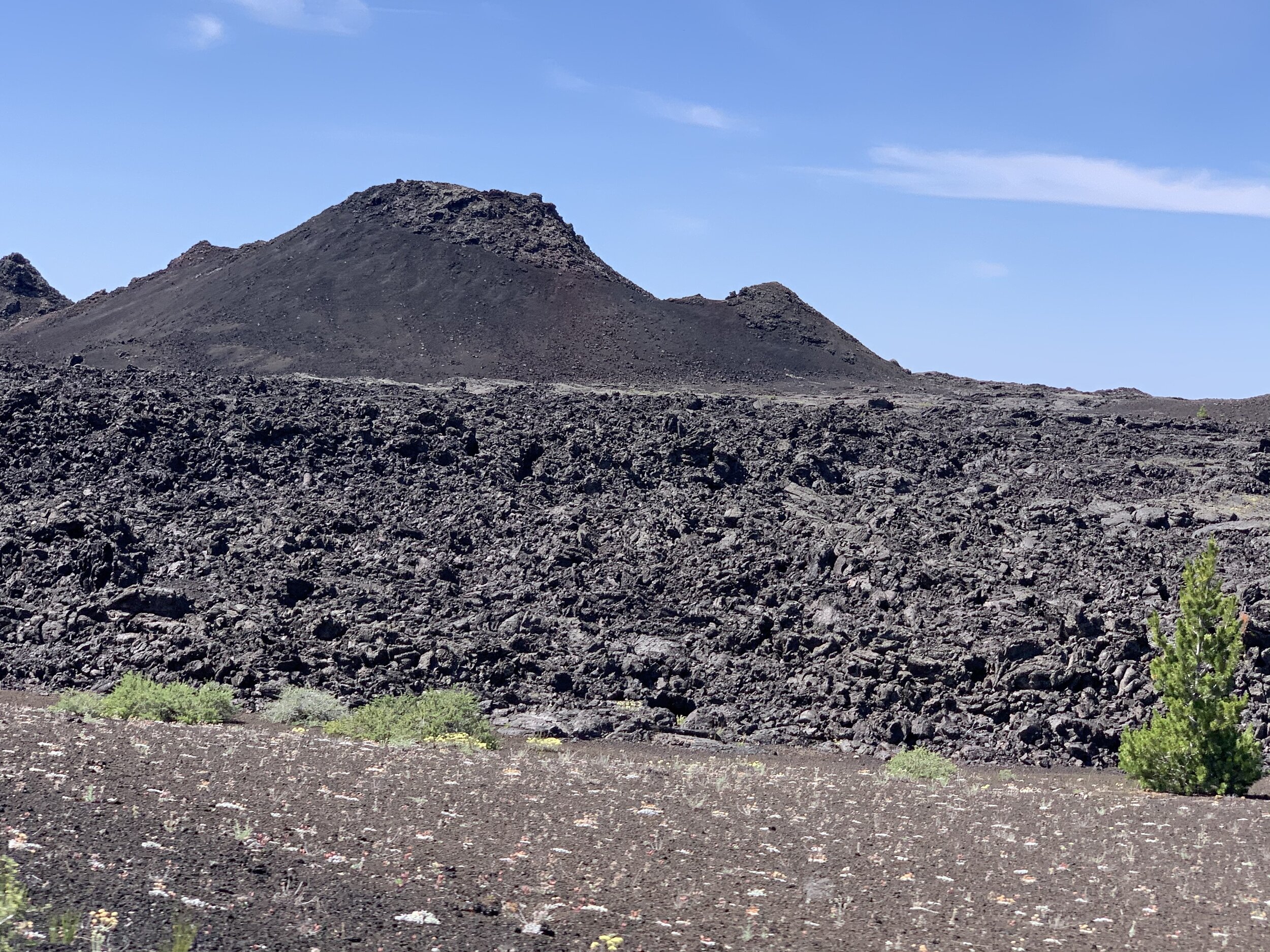
En route to our next destination, we stopped at Craters of the Moon National Monument & Preserve. This 1,117-square mile area in central Idaho was created by the lava flow of several volcanoes that erupted between 15,000 and 2,000 years ago. This is another area where the pictures cannot portray the immense colors and eeriness of the place. It really does look like another planet here.
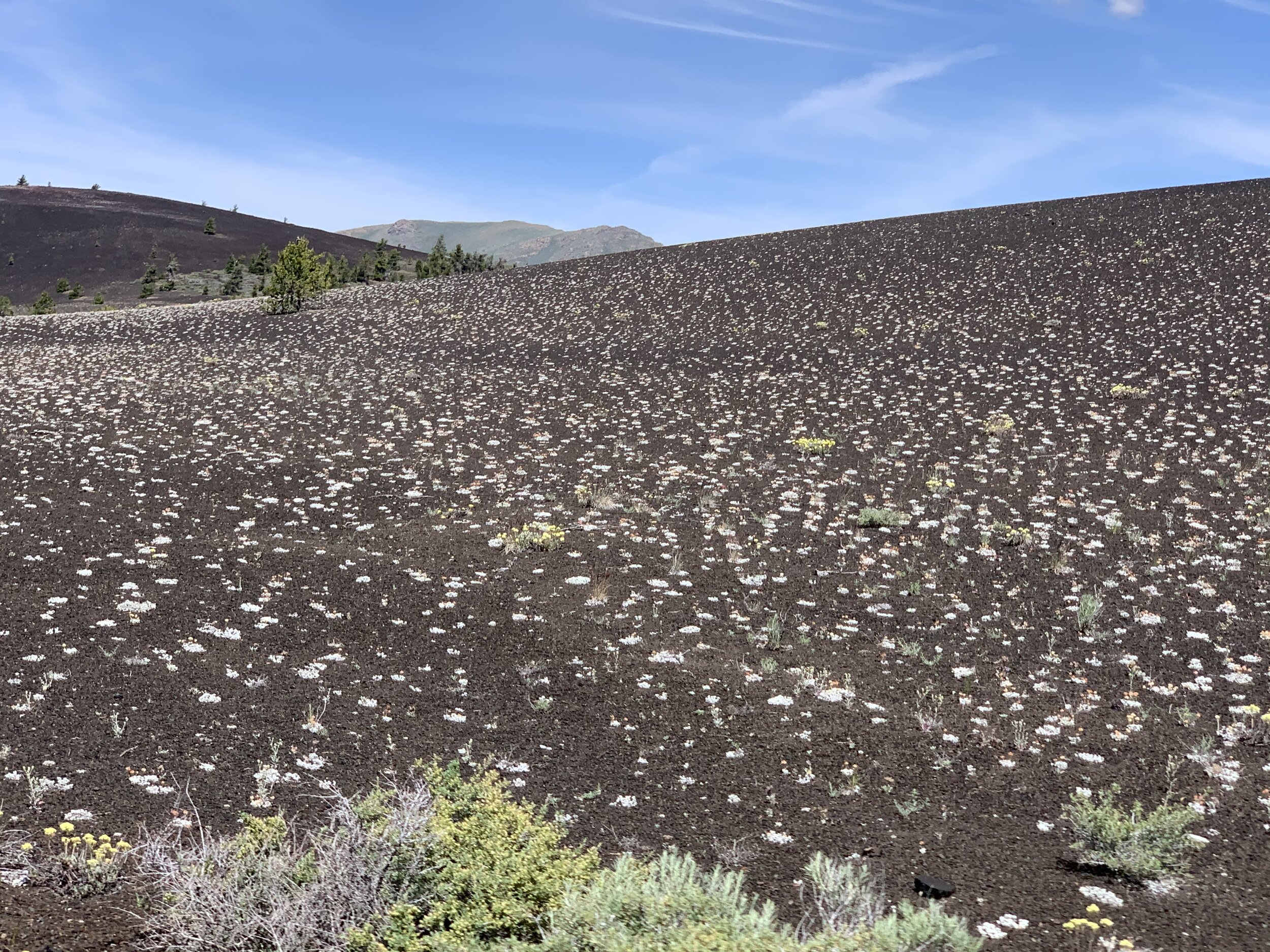
Surprisingly, there are thousands of various plants that live in the lava. The white spots here are shoots of Drawf Buckwheat, a delicate, adorable plant when viewed up closely.
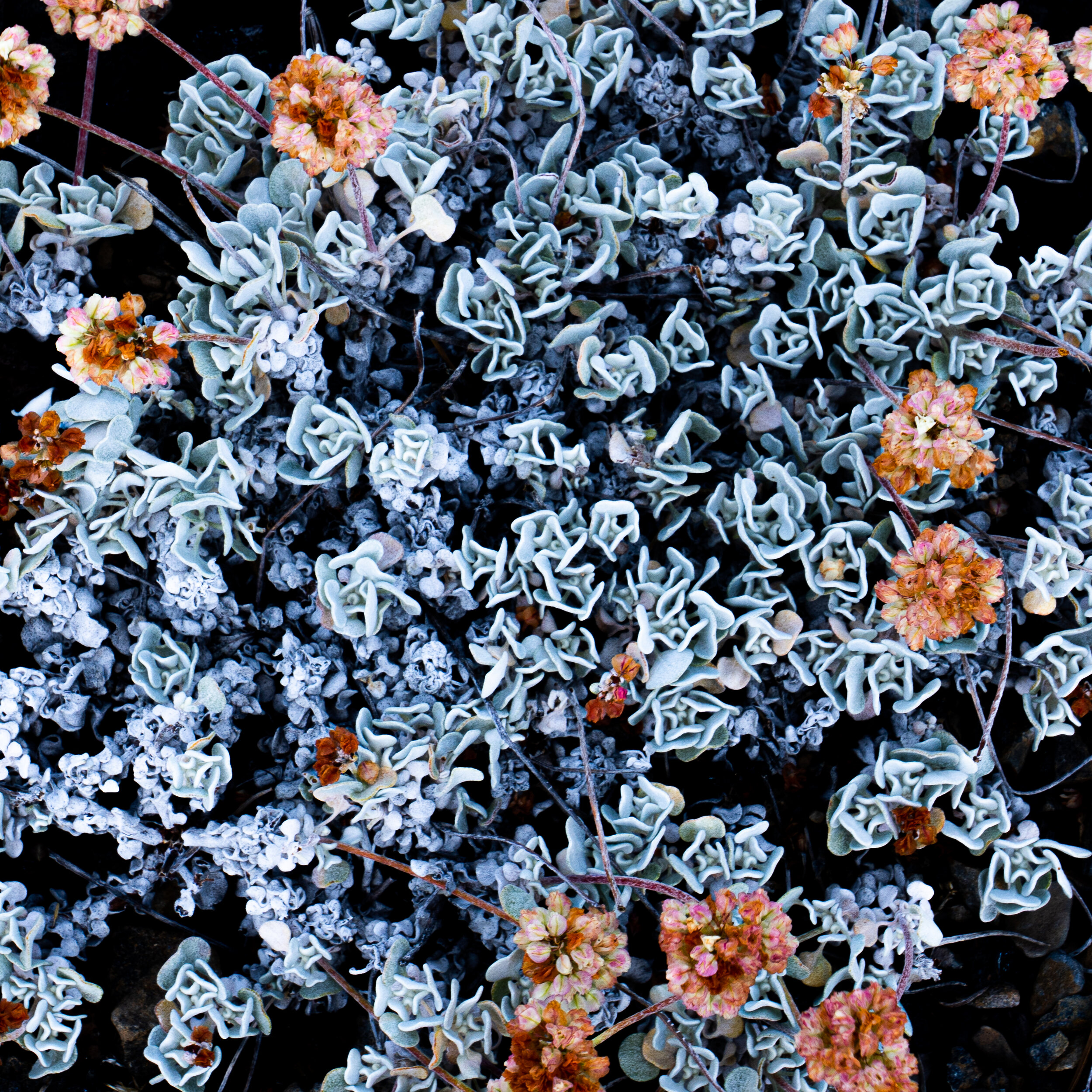
Craig captured an up-close shot of Drawrf Buckwheat for you. Isn’t it cute? 😀
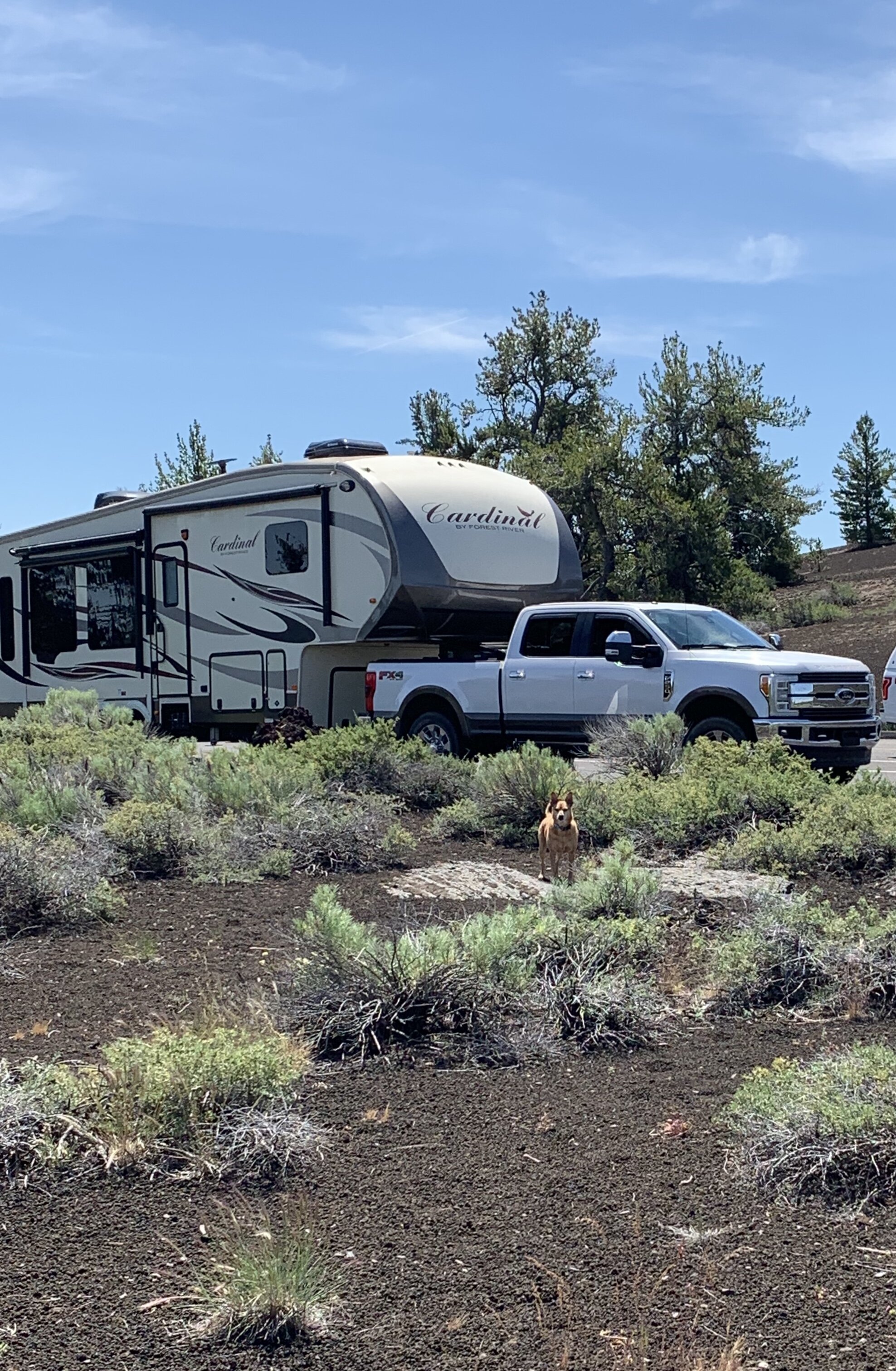
The smaller lava rocks crunched under our feet like Rice Krispies as we walked. Clay didn’t like it. Usually right on our heels, he did not want to walk on it and stood by the truck, urging us to get out of this strange place.

We’ve stayed at some really beautiful campsites. In the small town of Ashton, ID, our campsite backed up against a lovely private farm. We also just happened to have a view of the Grand Tetons about 40 miles away.
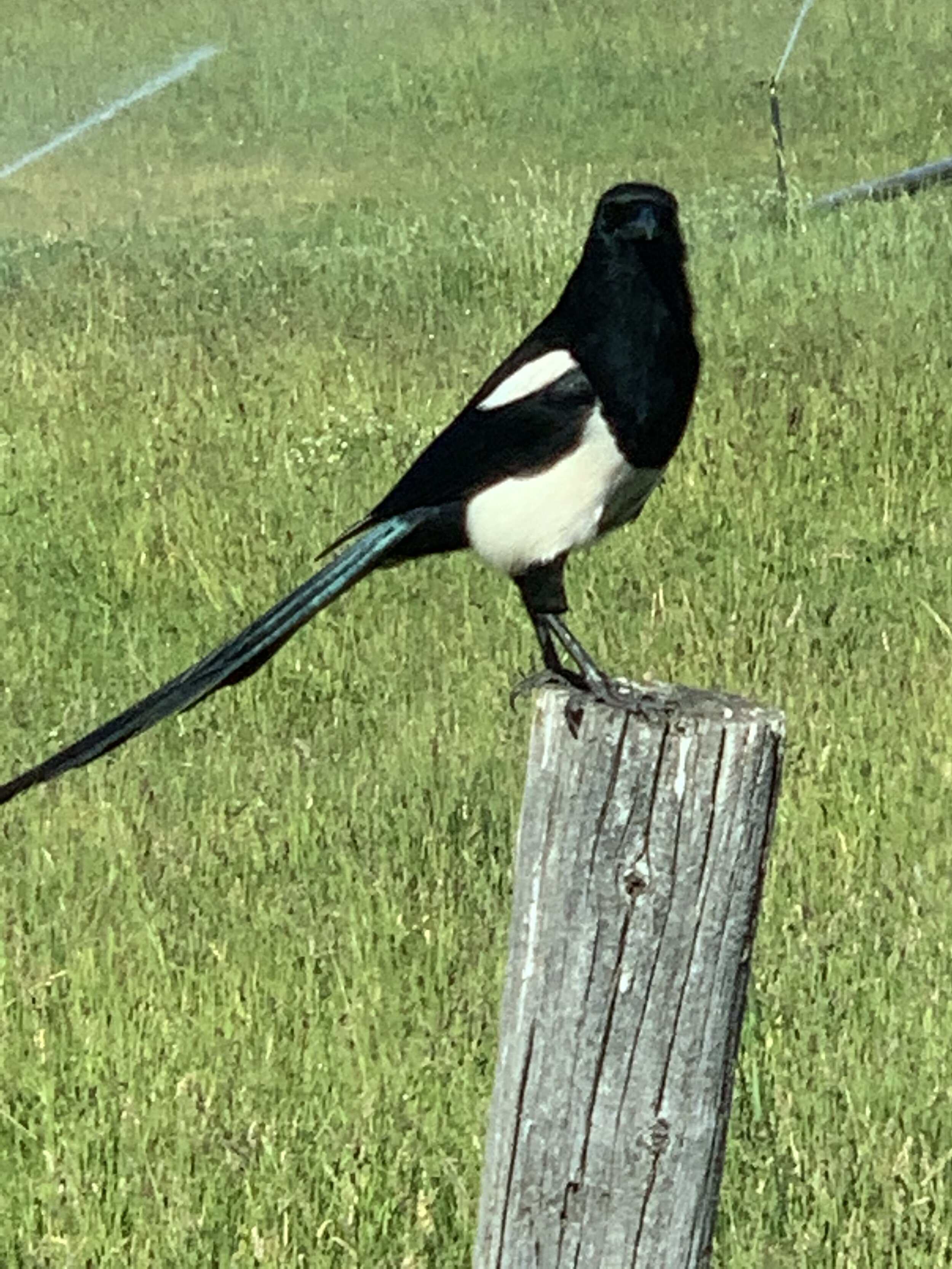
Magpies were all around our camper in Ashton. The magpie is considered one of the most intelligent animals in the world and one of only a few non-mammal species able to recognize itself in a mirror! They’re also very territorial and do not think twice about attacking people that walk too close to their nests. Magpies recognize and remember human faces, and good or bad encounters with a particular human for years. I hope we’re making a good impression; it looks like he’s planning to remember us.
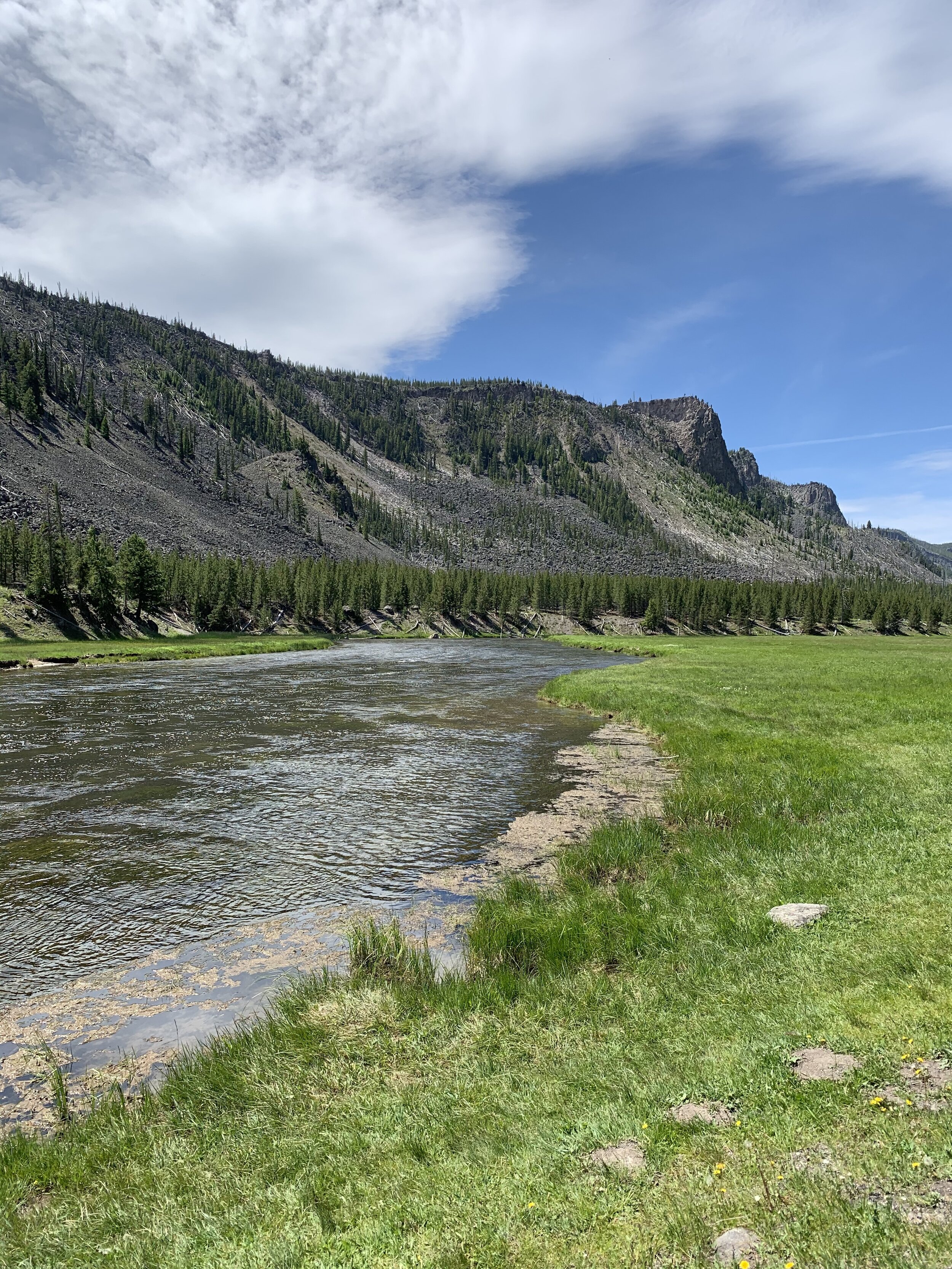
We stopped immediately upon arrival into Yellowstone National Park and took a picture of this peaceful stream. It felt like we should see bear, elk or moose or something enjoying a cool drink or fishing for salmon. A primary objective of the day was to see some wildlife!
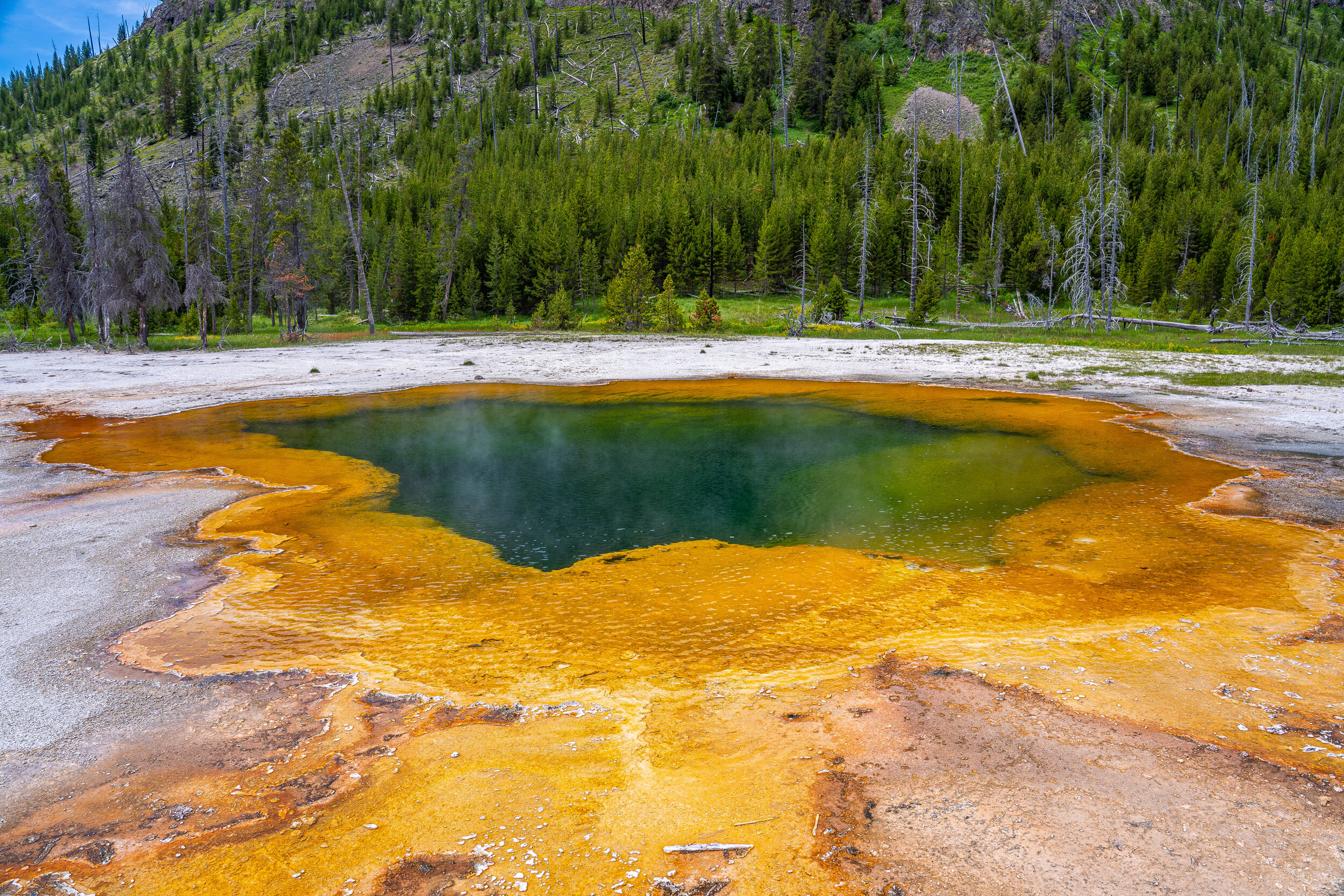
The hot springs and pools at Yellowstone are always a treat to see. Various heat-loving bacteria give the pools their bright and varied colors. Different colors represent different types of bacteria.
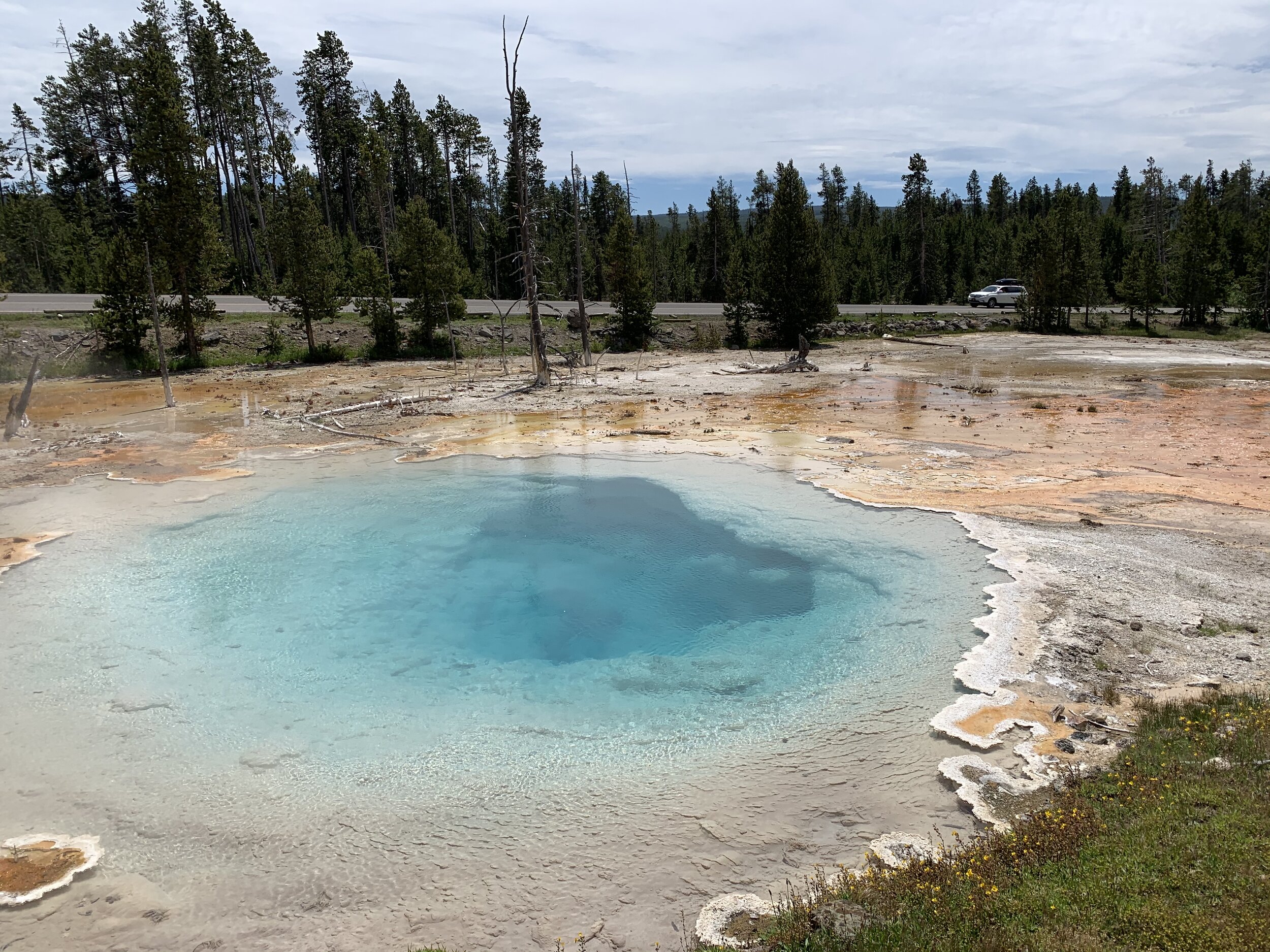
The colorful hot springs and pools of Yellowstone NP are always interesting.
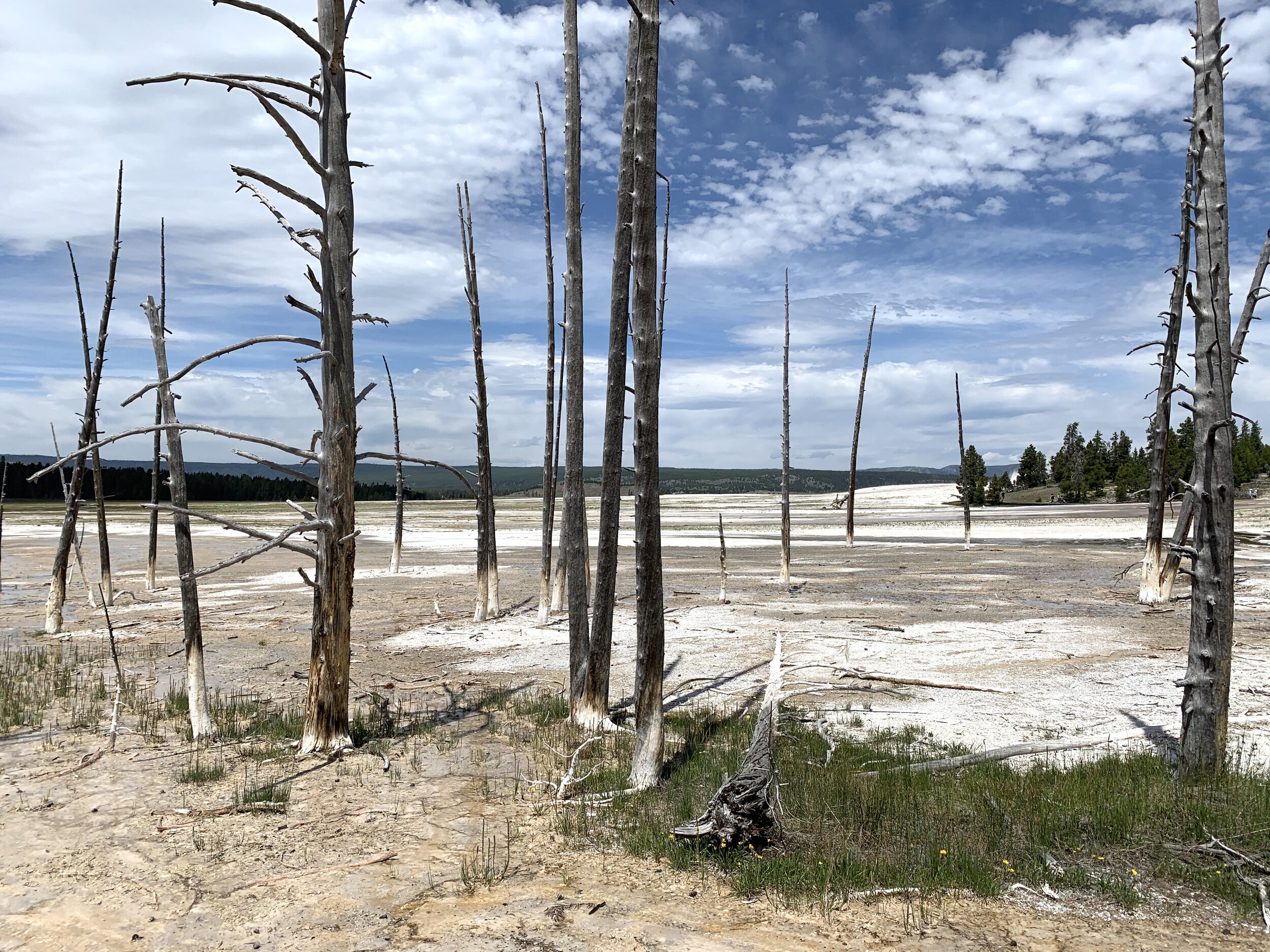
Because of the acidity of the pools, many other living organisms have a tough time living here.

The geysers and springs are acidic because they are fed by thermal water deep underground that picks up sulfuric acid as it rises to the surface. For this reason, they can be very dangerous to humans if safety guidelines are not followed. In recent years, a young man fell into one of the pools. It was not good.
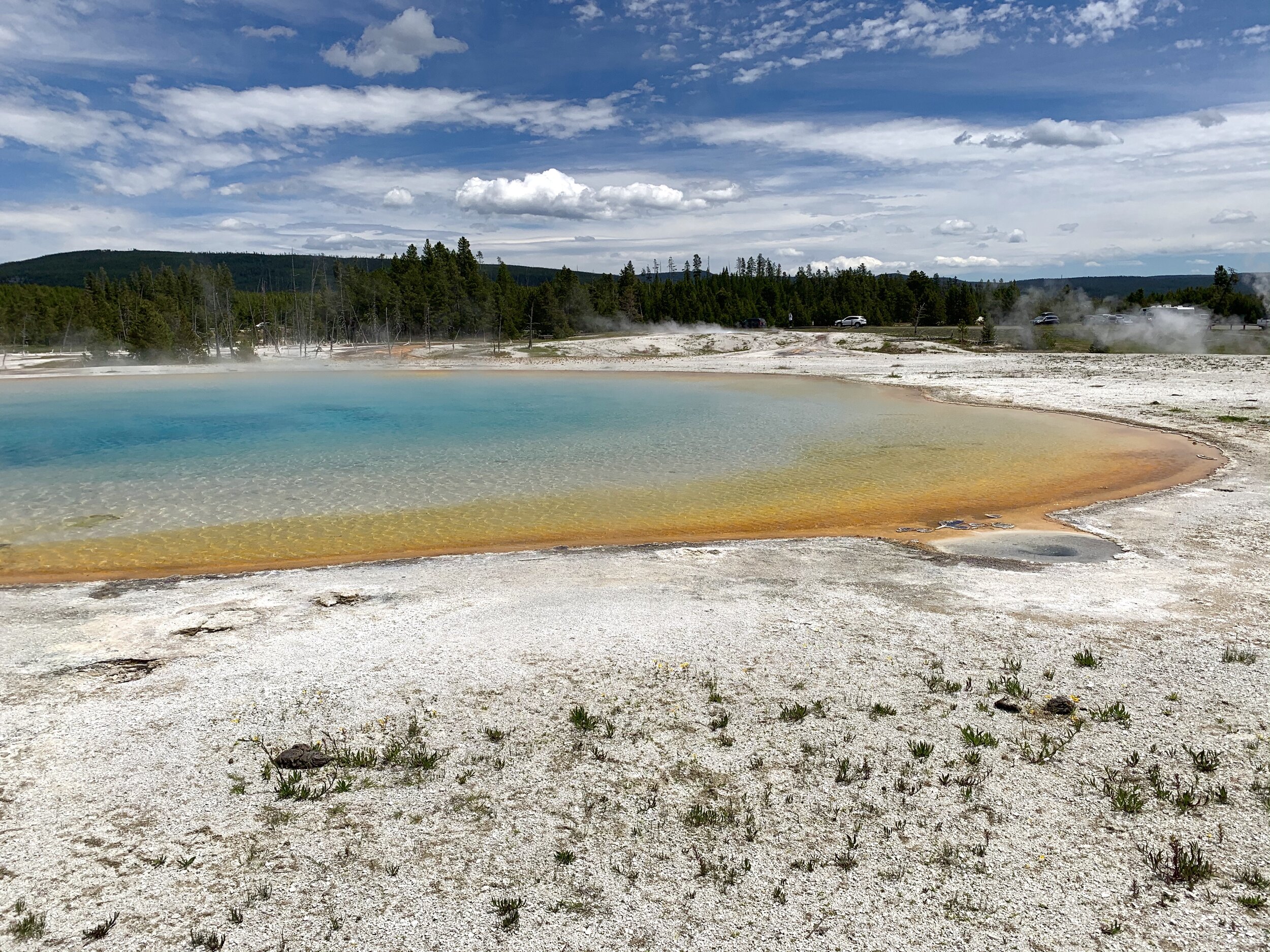
One last picture of the hot springs of Yellowstone.
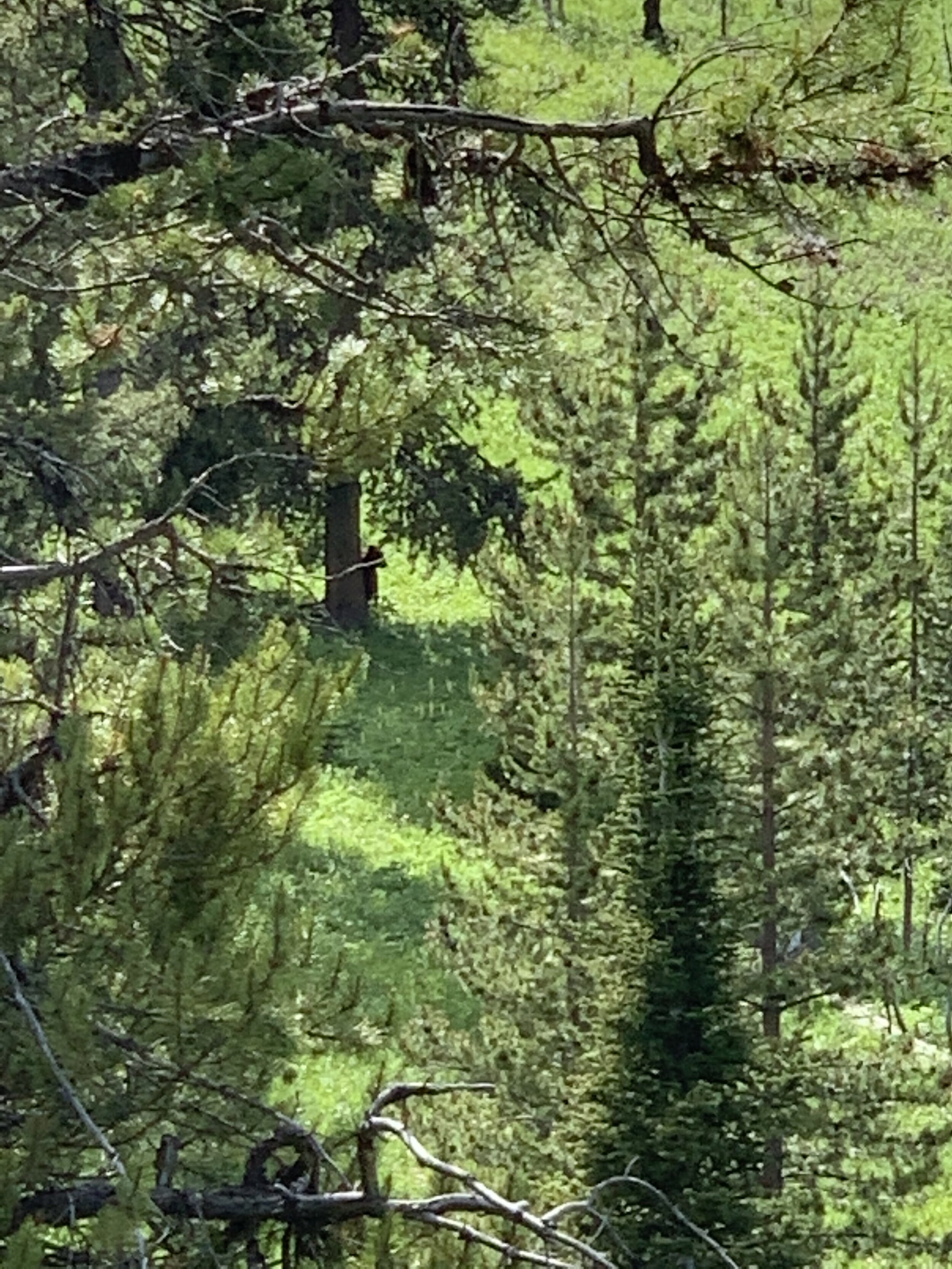
Well, there it is, Folks—The only large wildlife sighting of the whole day. Do you see it? Also note this picture is zoomed in and blown up about 10,000 times. Not exactly the wildlife encounter we were hoping for. 😂

Grand Teton National Park covers about 480 square miles and is made up of the Teton Range (pictured here) and most of the northern sections of the surrounding valley known as Jackson Hole. This mountain range was named by French trappers who first saw the mountains and thought the three prominent mountain peaks reminded them of breasts. 🙄 Grand Teton—the tallest of the three—literally means, “Big tit.”
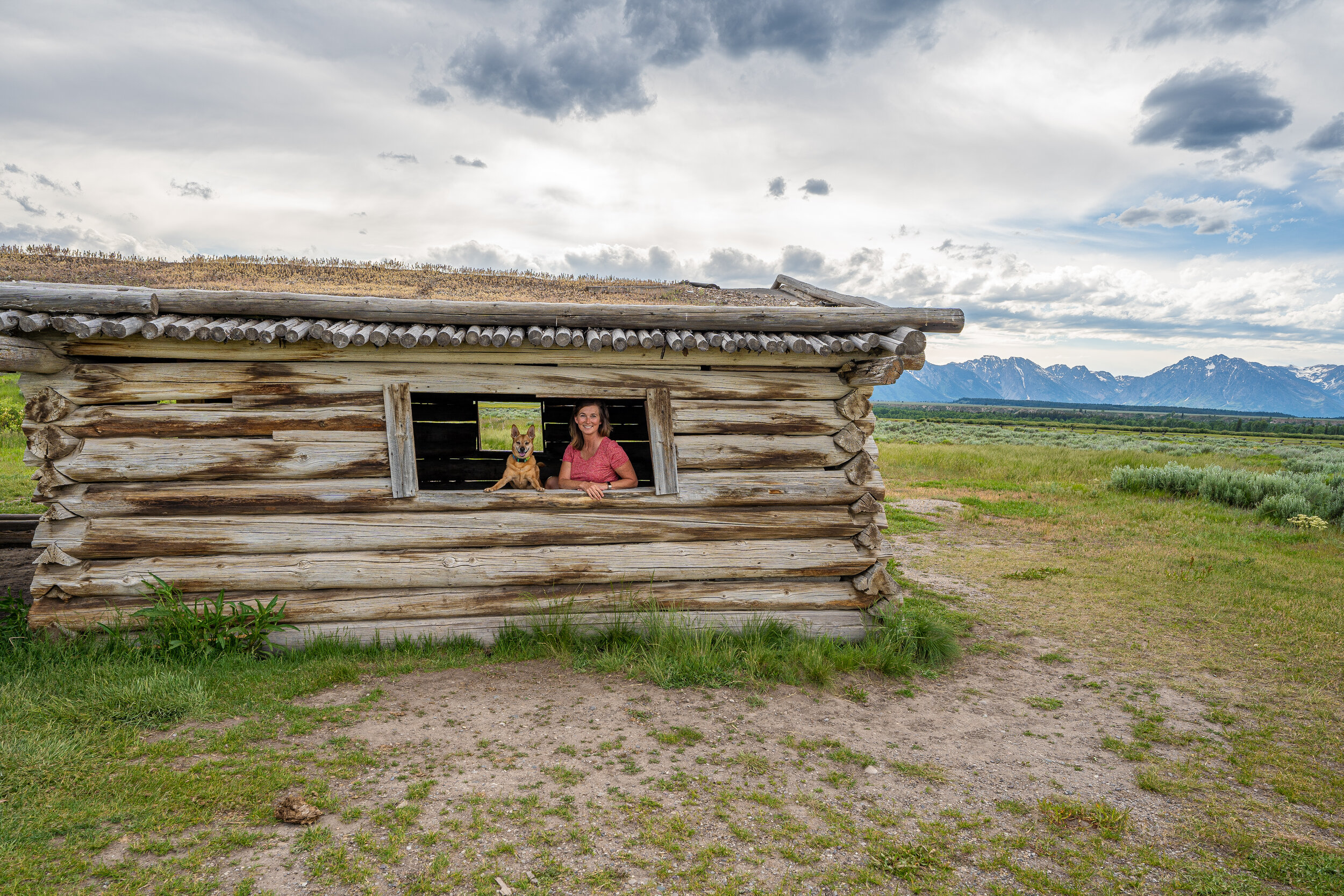
At Grand Teton NP we explored many old barns and buildings along Mormon Row Historic District. Mormon settlers arrived here from Idaho in the late 1800s and established 27 homesteads. Six homesteads remain along with drainage systems dug by hand for crop irrigation, barns, fields, and corrals.
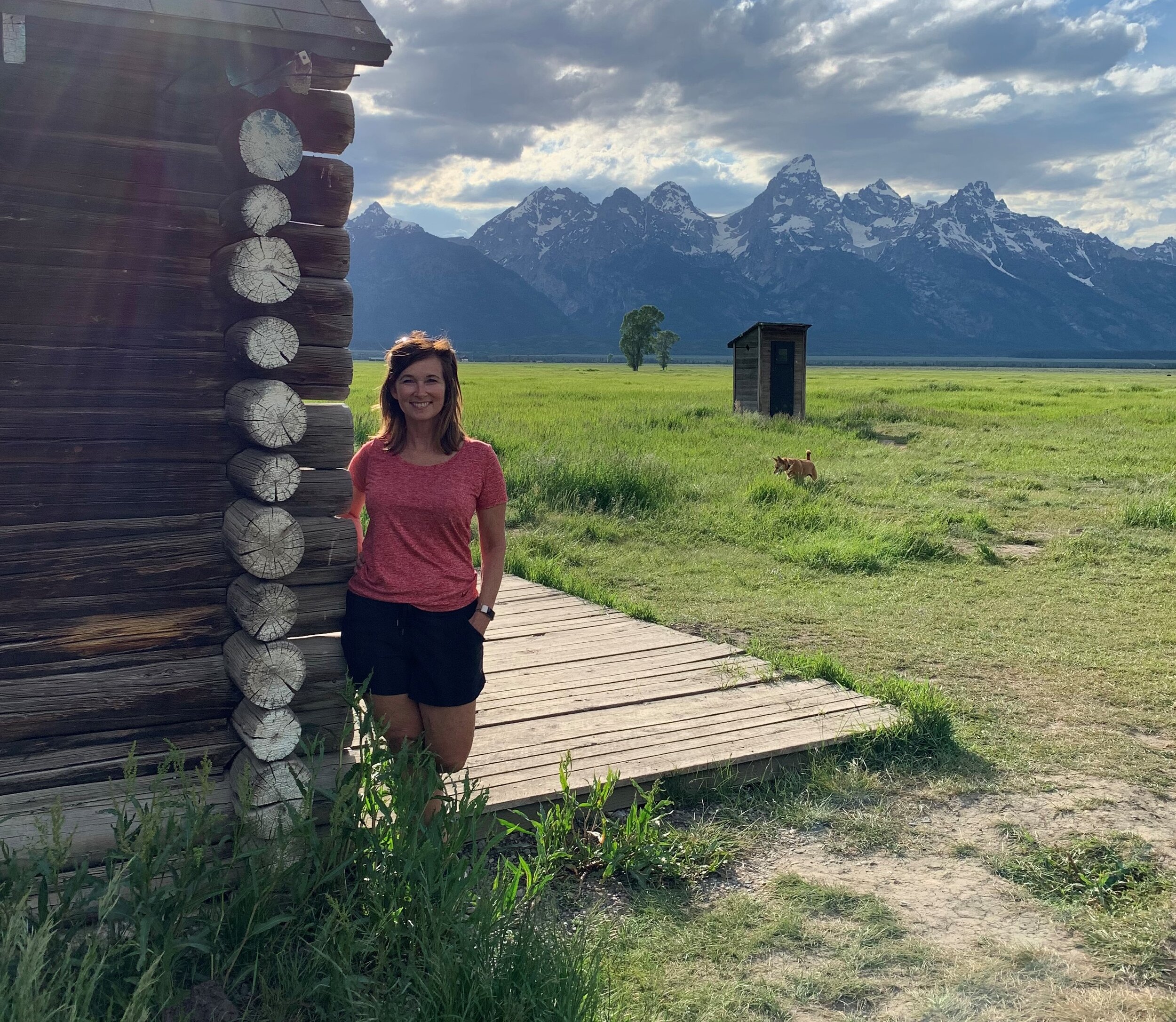
One old outhouse still remains as well.
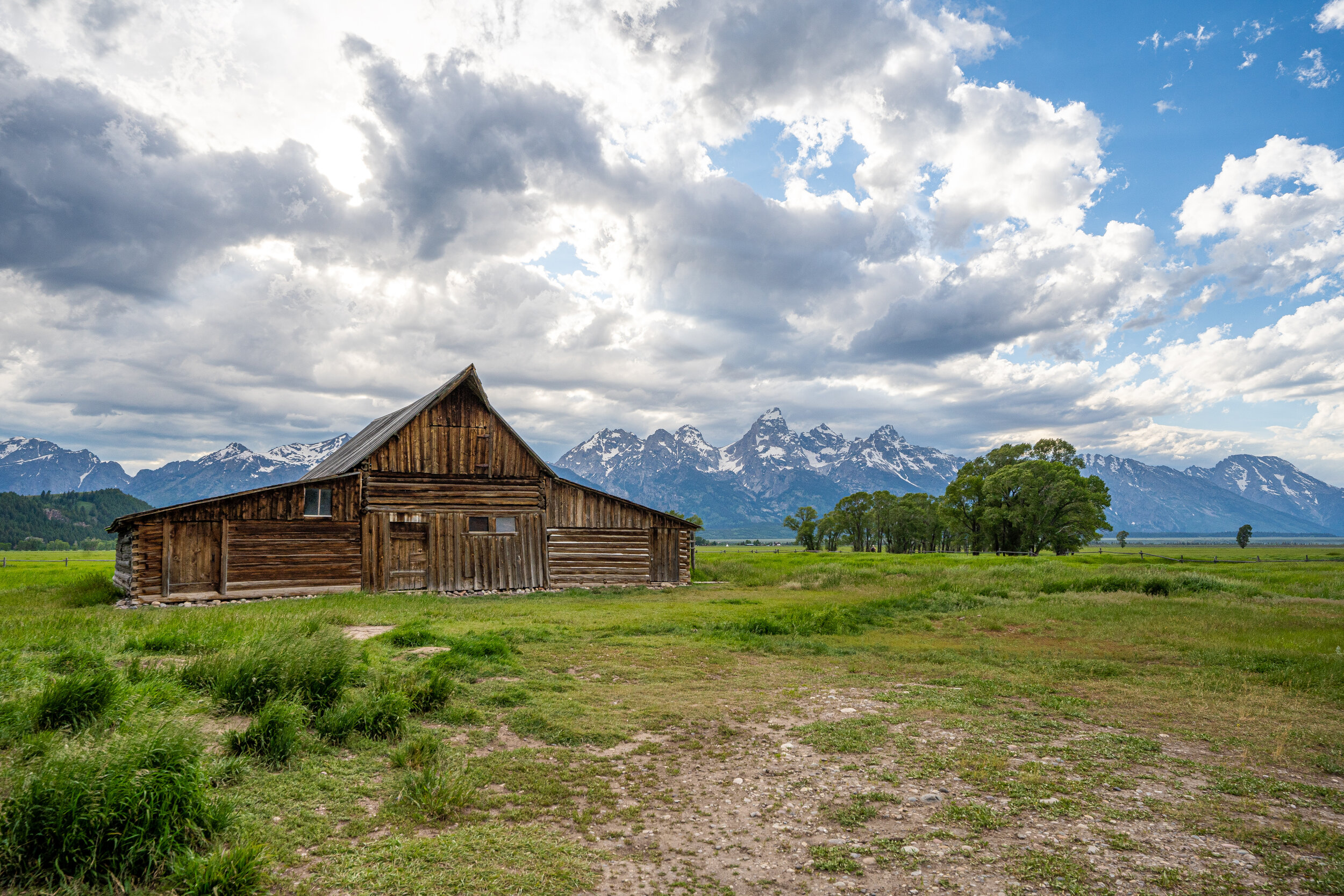
The most well-known of all the structures on Mormon Row is the famous T.A. Moulton Barn. You’ve probably seen a framed photograph or painting or completed a 1000-piece puzzle of this famous barn with the Teton Range in the background.
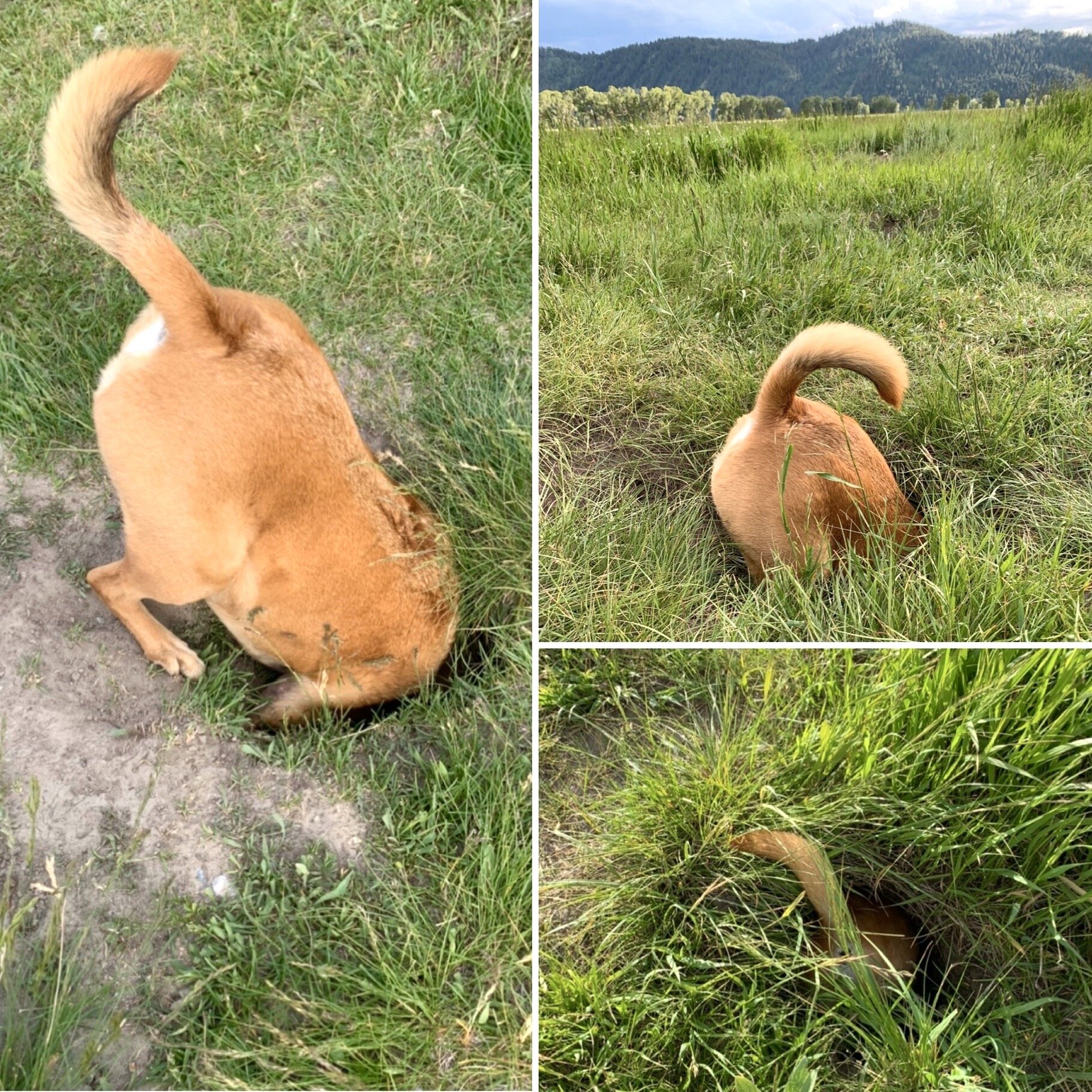
Hands down, Clay’s favorite part of visiting the Grand Tetons was looking for prairie dogs. A vast stretch of land with hundreds of holes, prairie dogs would pop up and whistle at him, sometimes waiting until he was almost upon them, then drop straight down into their holes. Clay ran from hole to hole for as long as we would let him. As you can see, some of the holes are quite large!
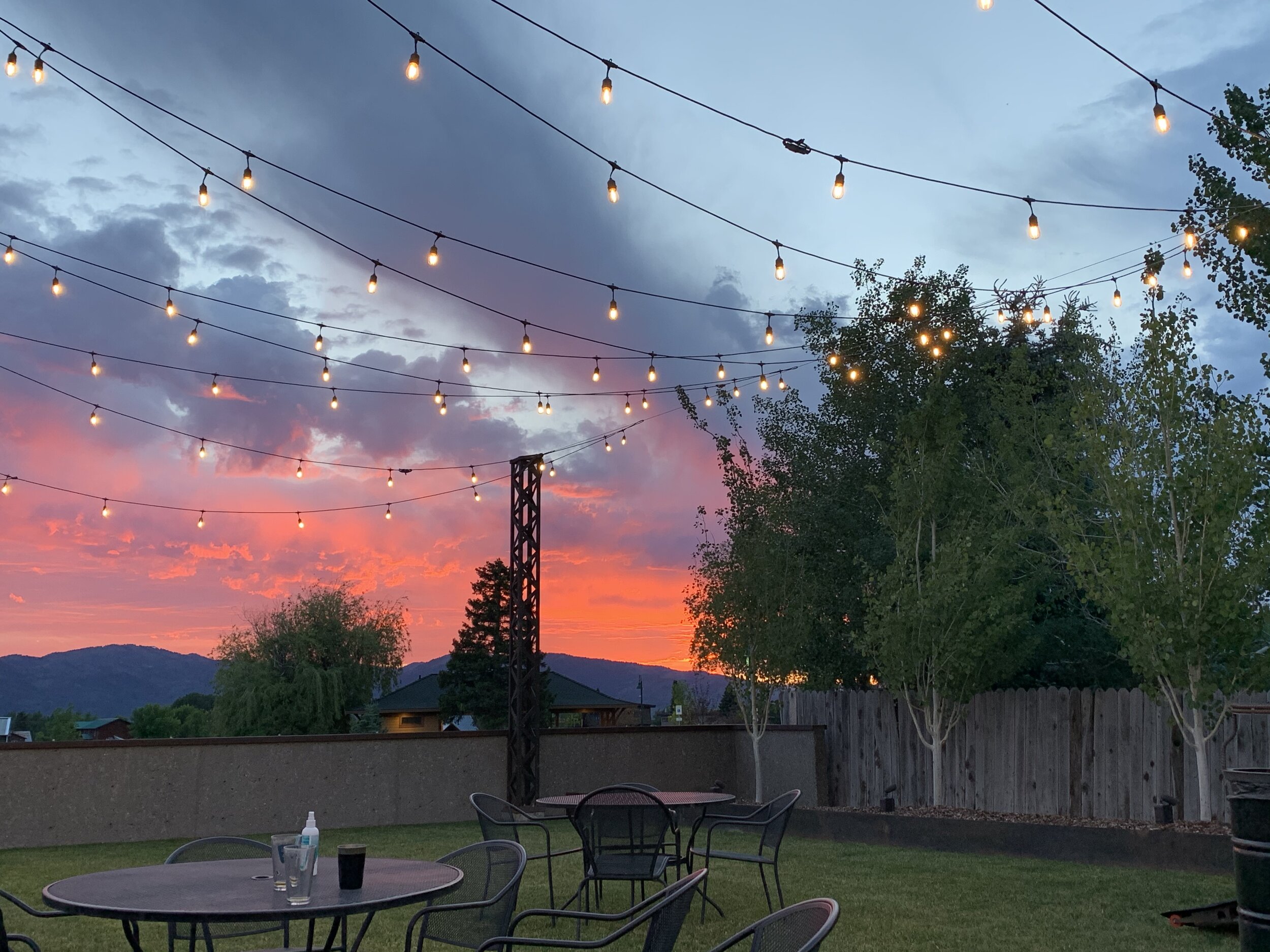
After a full day in Yellowstone and Grand Tetons National Parks, we found this treasure in Victor, ID. A great place for dinner and an incredible sunset to boot!

Another picture of the sky that changes minute-by-minute and this cool brewery we visited in Victor.

If you’re not regularly traveling around in an RV, you may not be privy to some of the RV culture. While there are many who enjoy a life of luxury on the road in $350,000+ rigs, there are also those that get a bit creative. We thought we’d share a few we’ve seen. This “back in the day” rock-band style tour bus would probably have some interesting stories to tell if it could talk.

Take a Hertz rental truck, add a window, and Voilá!…you now have a camper!
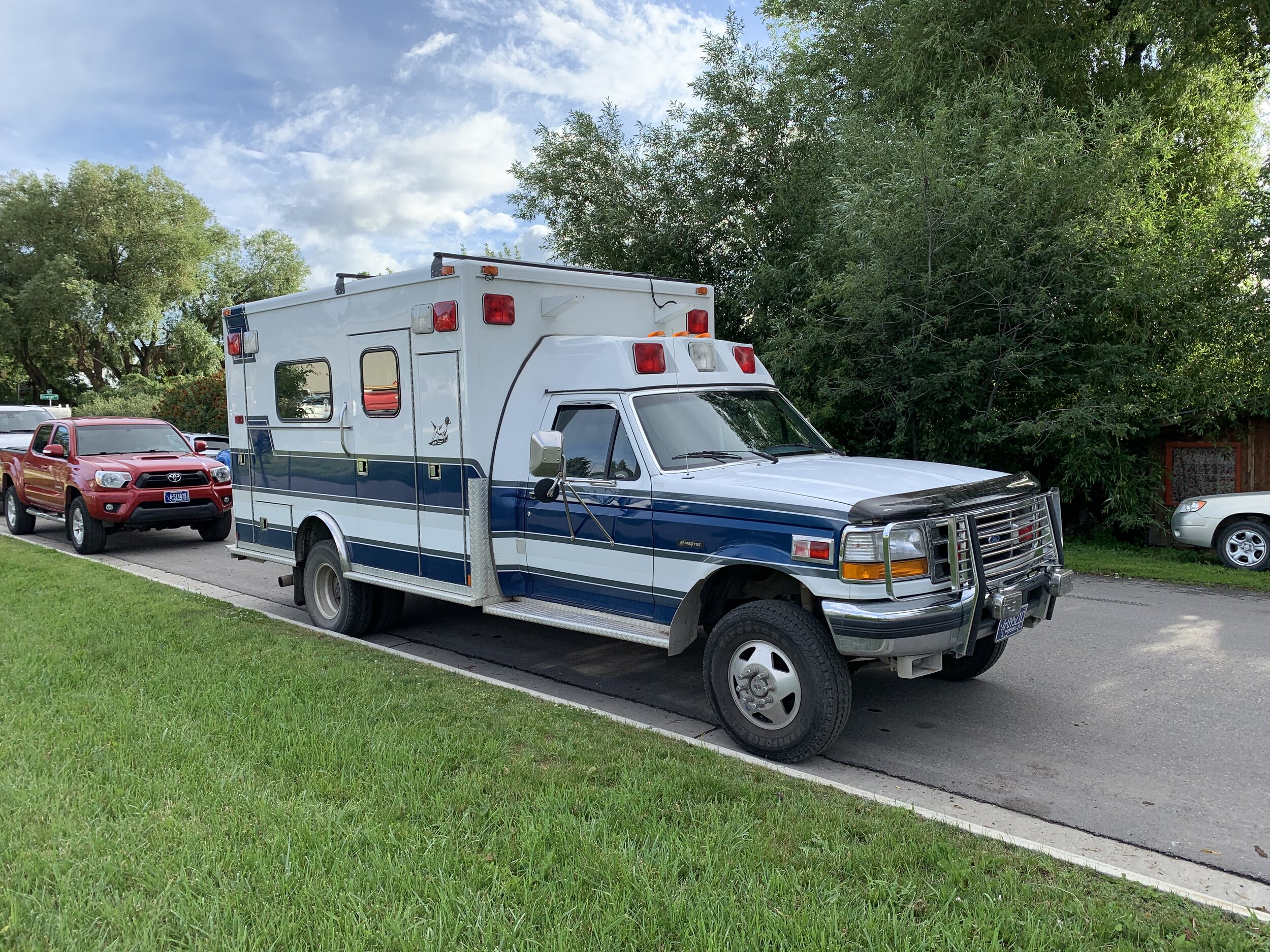
Is there an emergency?
YES! Let’s get out of town and go camping!
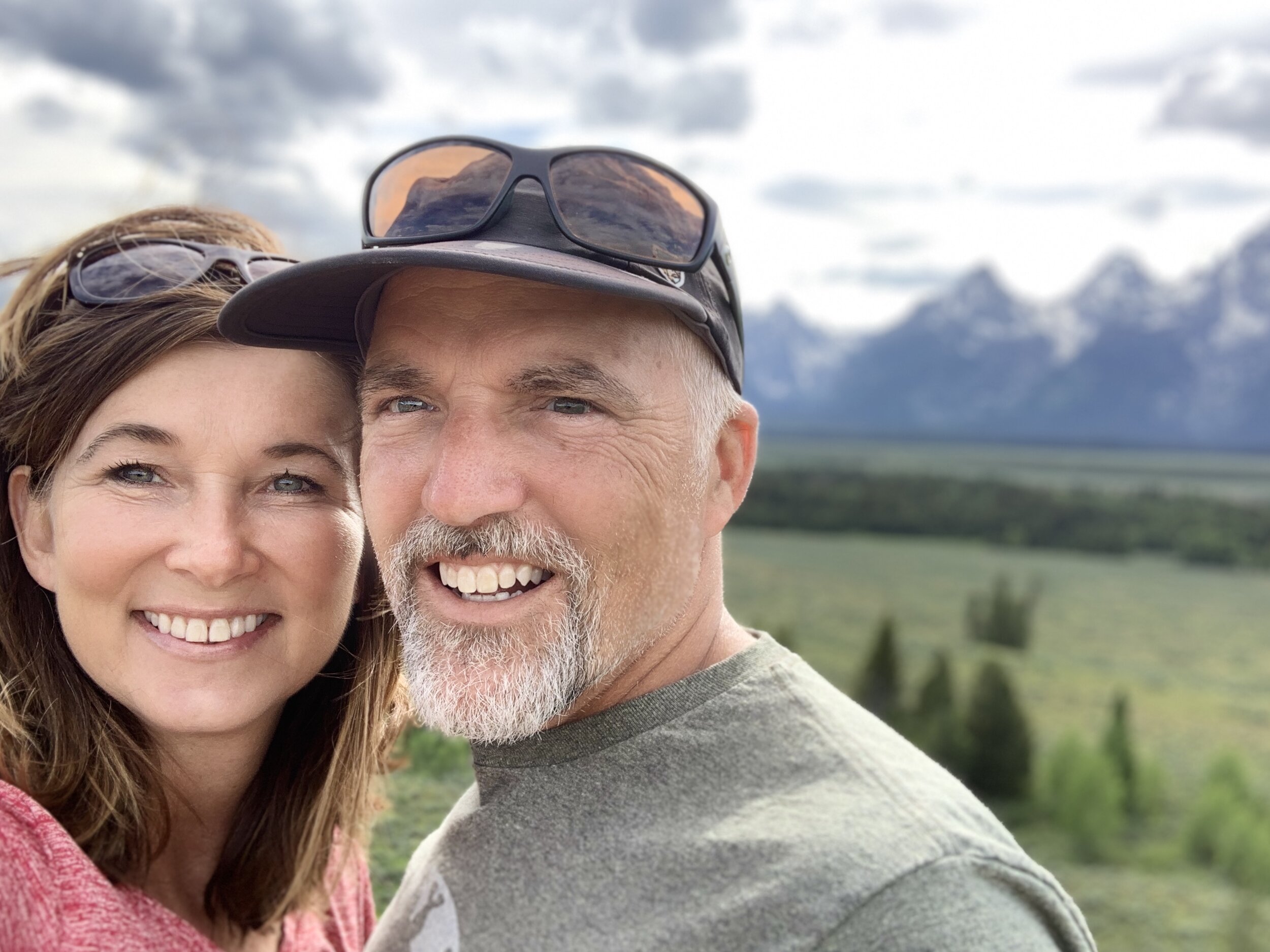
Until next time, lots of love to you all! See you in Montana! 💓🤍💙

